Jessica Knauss's Blog, page 6
June 11, 2019
A Weekend in the Life: A Wedding and a Pilgrimage
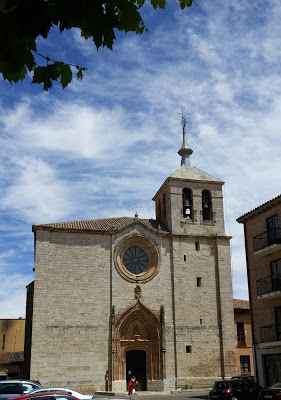 San Julián de los Caballeros, Toro, after the wedding
San Julián de los Caballeros, Toro, after the weddingAll photos in this post 2019 Jessica Knauss
unless otherwise specified Though I usually blog about the history I find on trips I've taken, sometimes you can have an extraordinary weekend staying close to home. Especially when you live in Spain. To start it off, on Saturday, my choir, the Coral Ciudad de Zamora, sang at a wedding in Toro. I haven't mentioned Toro on this blog before, but that's my bad. It's Zamora province's second capital and about as packed with thrilling history as Zamora. We carpooled to get there, and the lady I rode with, who sings tenor (although she would like to sing bass), parked next to the castle. This is not something you can do at all in the United States, but isn't worth batting an eye in Toro.
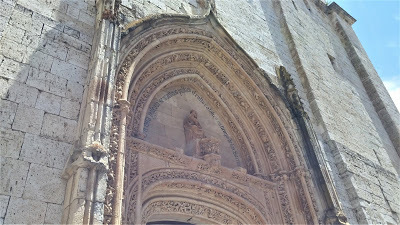 The wedding took place in the Church of San Julián de los Caballeros, a sixteenth-century Gothic structure on the site of a much more ancient sanctuary. Gothic letters on the facade proclaim, "Here the Christian faith was publicly practiced in the time of the 'saracens.'" Alfonso III gave the "repopulation" order for Toro in 910, so this is a reference to worship taking place here in the ninth century and earlier. Such antiquity shouldn't surprise in Toro, which was probably established before 220 BCE.
The wedding took place in the Church of San Julián de los Caballeros, a sixteenth-century Gothic structure on the site of a much more ancient sanctuary. Gothic letters on the facade proclaim, "Here the Christian faith was publicly practiced in the time of the 'saracens.'" Alfonso III gave the "repopulation" order for Toro in 910, so this is a reference to worship taking place here in the ninth century and earlier. Such antiquity shouldn't surprise in Toro, which was probably established before 220 BCE.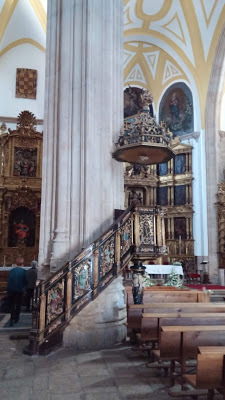 Gothic pulpit We had the chance to look around in the church, change into choir robes in the sacristy, and warm up before any guests arrived.
Gothic pulpit We had the chance to look around in the church, change into choir robes in the sacristy, and warm up before any guests arrived.Hardly anybody came into the church before the ceremony started. A fellow soprano said they were waiting around outside to catch a glimpse of the bride. No way! Rather than follow the rules, the Spanish don't mind spoiling the surprise.
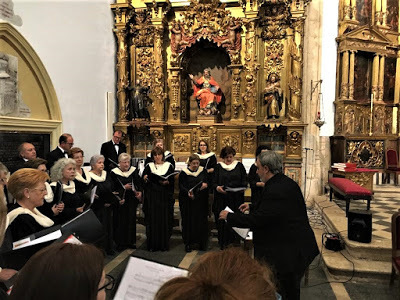 An alto's husband took this photo of us during warmups. The groom was handsome, the bride elegant. The choir didn’t make any obvious flubs, and word from the family is that our contribution was thoroughly appreciated. Although there didn't seem to be a videographer, as I've seen at most American weddings, two photographers pestered the bride and groom and ignored us completely. Choirs at weddings in Spain must be so normal as to not need a photographic reminder.
An alto's husband took this photo of us during warmups. The groom was handsome, the bride elegant. The choir didn’t make any obvious flubs, and word from the family is that our contribution was thoroughly appreciated. Although there didn't seem to be a videographer, as I've seen at most American weddings, two photographers pestered the bride and groom and ignored us completely. Choirs at weddings in Spain must be so normal as to not need a photographic reminder.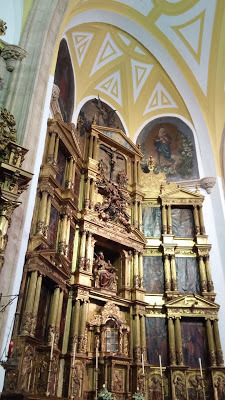 Main altar There was mass while the bride and groom were seated. They exchanged vows, rings, and arras, coins symbolic of dowry and bride price, though they said they were symbolic of the fortunes the bride and groom would enjoy together.
Main altar There was mass while the bride and groom were seated. They exchanged vows, rings, and arras, coins symbolic of dowry and bride price, though they said they were symbolic of the fortunes the bride and groom would enjoy together.The groom's brother carried a cardboard sign nicely lettered with "Don't worry, ladies, I'm still single!" Well, that's a relief!
The groom’s new aunt read a text of blessing as a surprise, and a nervous friend sang a short song, sitting in the pews. It wasn't the performance of the year, as the choir commented afterward, but I was moved by her sentiment.
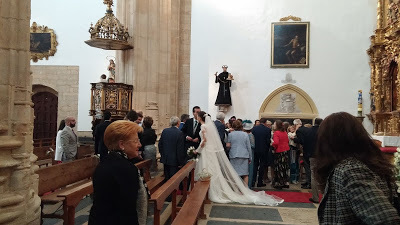 A meet-and-greet instead of a recessional Though we sang an upbeat song by Monsignor Marco Frisina as a recessional, the wedding party didn't leave the church at the end. All the invited friends and family went up to them near the altar to congratulate them. Outside, there were three baskets with different things to throw at the couple when they did come out: rice, rose petals, and confetti canons.
A meet-and-greet instead of a recessional Though we sang an upbeat song by Monsignor Marco Frisina as a recessional, the wedding party didn't leave the church at the end. All the invited friends and family went up to them near the altar to congratulate them. Outside, there were three baskets with different things to throw at the couple when they did come out: rice, rose petals, and confetti canons.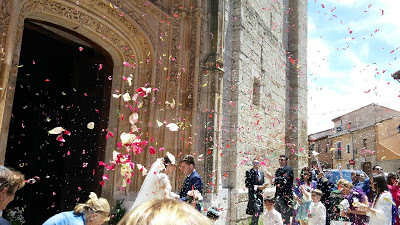
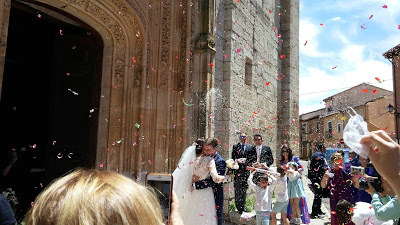 This is the first wedding I've been to since I became widowed. I almost broke down in tears during the exchange of rings, thinking widow thoughts that would be a real downer to anyone who's been spared losing the love of their life. And then, looking at the happy couple being pelted with the modern remnants of fertility symbols, I couldn't help but feel optimistic. The day was emotionally exhausting because of these ups and downs. Grief always comes back around with the same intensity, but at least I find that now, nearly three years in, I recover from such triggers quickly, with a little rest.
This is the first wedding I've been to since I became widowed. I almost broke down in tears during the exchange of rings, thinking widow thoughts that would be a real downer to anyone who's been spared losing the love of their life. And then, looking at the happy couple being pelted with the modern remnants of fertility symbols, I couldn't help but feel optimistic. The day was emotionally exhausting because of these ups and downs. Grief always comes back around with the same intensity, but at least I find that now, nearly three years in, I recover from such triggers quickly, with a little rest.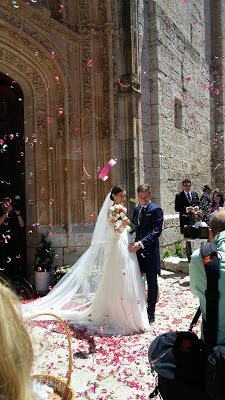
 Singing at a wedding on Saturday would've been enough to distinguish this weekend from any other in my life, but Zamora can be relentless. It provided another unique event to transport me to yet another world.
Singing at a wedding on Saturday would've been enough to distinguish this weekend from any other in my life, but Zamora can be relentless. It provided another unique event to transport me to yet another world.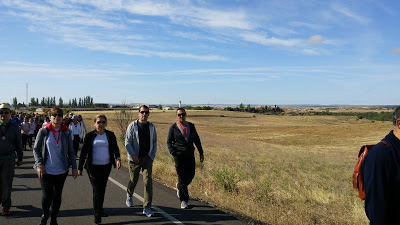 The highway is blocked to car traffic on the morning of Pentecost Monday every year. June in Spain is synonymous with weddings, but also with romerías. The translation is "pilgrimages," but yet again, something is lost in that transfer. A romería, unlike what we usually think of as a pilgrimage, is a local affair, something that can be undertaken in a single day by an entire community. It turns out looking like a mass migration to the countryside for the day. The most famous is the romería from Sevilla to El Rocío, but I've seen national news reports on many others all over the country.
The highway is blocked to car traffic on the morning of Pentecost Monday every year. June in Spain is synonymous with weddings, but also with romerías. The translation is "pilgrimages," but yet again, something is lost in that transfer. A romería, unlike what we usually think of as a pilgrimage, is a local affair, something that can be undertaken in a single day by an entire community. It turns out looking like a mass migration to the countryside for the day. The most famous is the romería from Sevilla to El Rocío, but I've seen national news reports on many others all over the country. 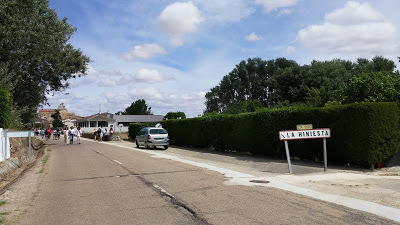 Guess what? Zamora's romería claims to be the oldest continually performed such ritual. The media claims this is the 729th year! In about the year 1290, it's said young King Sancho IV (Alfonso X's son) was out hunting in the area of present-day La Hiniesta when the Virgin Mary appeared to him in a broom shrub (hiniesta). He had the church that is now the center of town built to commemorate that auspicious moment. And people have been making the pilgrimage out here from Zamora on Pentecost ever since.
Guess what? Zamora's romería claims to be the oldest continually performed such ritual. The media claims this is the 729th year! In about the year 1290, it's said young King Sancho IV (Alfonso X's son) was out hunting in the area of present-day La Hiniesta when the Virgin Mary appeared to him in a broom shrub (hiniesta). He had the church that is now the center of town built to commemorate that auspicious moment. And people have been making the pilgrimage out here from Zamora on Pentecost ever since. 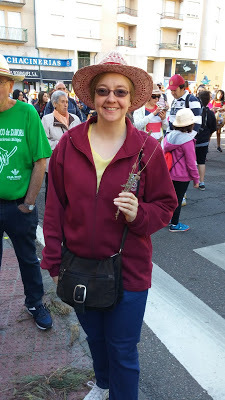 Someone who goes on romería is a romero,
Someone who goes on romería is a romero,so sprigs of romero (rosemary) are required. Last year, the romería came up without enough warning for me to consider doing it. Besides, walking seven kilometers there and seven more back by myself in a crowd didn't appeal when I was finishing up my first school year and preparing for an epic journey with my wonderful mother.
This year June 10, a Monday, was a holiday in Zamora and nowhere else. Chatting with my roommate, Fernando, the romería to La Hiniesta came up casually with enough time beforehand for him to consider that since I love Zamora and haven't done it before, perhaps he could do me the extraordinary favor of guiding me through the experience.
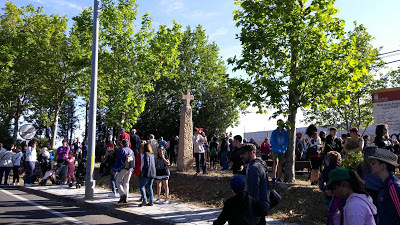 The Cross of Don Sancho, one of the important stops along the way I needed a local guide because these things are hard to pin down, even if they've published schedules and itineraries. I wouldn't have known what time to be at the church from which the Patroness of Zamora, the Virgen de la Concha (Our Lady of the Shell), makes her grand exit. I also wouldn't have had the motivation to get up so early.
The Cross of Don Sancho, one of the important stops along the way I needed a local guide because these things are hard to pin down, even if they've published schedules and itineraries. I wouldn't have known what time to be at the church from which the Patroness of Zamora, the Virgen de la Concha (Our Lady of the Shell), makes her grand exit. I also wouldn't have had the motivation to get up so early.We showed up at San Antolín at 8:30 a.m. Only bakers and romeros (pilgrimage-goers) are up at that hour in Spain. Everyone else I'd talked to about it had said they were going to be away from Zamora on Monday, so I had the impression of a deserted city. That impression was the first thing corrected.
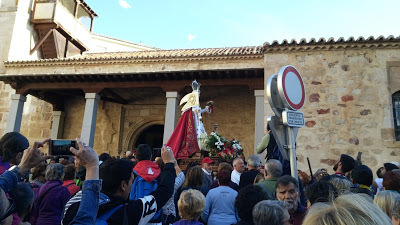 The Virgen de la Concha came out of San Antolín punctually to a march played by flute and tambor, a harsh type of oboe, and bagpipes. These musical groups spread out over the course of the route, but were most impressive when they were all together. The Virgen has been the Patroness of Zamora since 1100, but the current iconographically unique dressing image is from the eighteenth century. She stands proudly with a flag, and her Child stands next to her, united by a silver chain. The shell that gives her her name is also silver and tied around her waist over whatever elaborate robes she's dressed with. Because she's a dressing image, under the robes, she's a skeletal framework, making her relatively light, which must be a blessing on her romería day. Seven kilometers (4.35 miles) to La Hiniesta, a trip around the large church there, and seven kilometers back on the same day would test anyone's devotion.
The Virgen de la Concha came out of San Antolín punctually to a march played by flute and tambor, a harsh type of oboe, and bagpipes. These musical groups spread out over the course of the route, but were most impressive when they were all together. The Virgen has been the Patroness of Zamora since 1100, but the current iconographically unique dressing image is from the eighteenth century. She stands proudly with a flag, and her Child stands next to her, united by a silver chain. The shell that gives her her name is also silver and tied around her waist over whatever elaborate robes she's dressed with. Because she's a dressing image, under the robes, she's a skeletal framework, making her relatively light, which must be a blessing on her romería day. Seven kilometers (4.35 miles) to La Hiniesta, a trip around the large church there, and seven kilometers back on the same day would test anyone's devotion.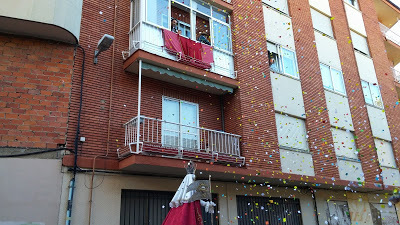
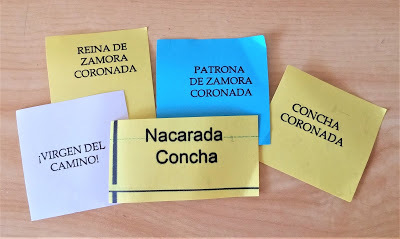 As she made her way down the sloped street to exit what was once the Fair Gate in the city wall, people in balconies threw confetti. This wasn't just any confetti. It had been cut with care from multicolored paper after being printed with all the Virgen's honorifics: Crowned Queen of Zamora, Crowned Patron of Zamora, Virgin of the Pilgrim's Way!, Mother-of-Pearl Shell, and Crowned Shell were the ones Fernando caught for me.
As she made her way down the sloped street to exit what was once the Fair Gate in the city wall, people in balconies threw confetti. This wasn't just any confetti. It had been cut with care from multicolored paper after being printed with all the Virgen's honorifics: Crowned Queen of Zamora, Crowned Patron of Zamora, Virgin of the Pilgrim's Way!, Mother-of-Pearl Shell, and Crowned Shell were the ones Fernando caught for me.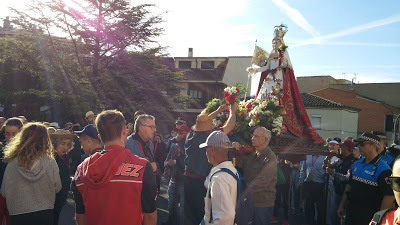 The idea is not to simply leave the temple and arrive at La Hiniesta in a timely manner. Several diversions, planned and improvised, kept boredom at bay throughout the trip. Among the spontaneous events, some people waited by the side of the road for the procession to pass by, holding flowers. If they held the flowers up while the Virgen approached, the float stopped and allowed the people to make votive offerings of the flowers. One of the brotherhood members would take the flowers and arrange them on the float as he saw fit.
The idea is not to simply leave the temple and arrive at La Hiniesta in a timely manner. Several diversions, planned and improvised, kept boredom at bay throughout the trip. Among the spontaneous events, some people waited by the side of the road for the procession to pass by, holding flowers. If they held the flowers up while the Virgen approached, the float stopped and allowed the people to make votive offerings of the flowers. One of the brotherhood members would take the flowers and arrange them on the float as he saw fit.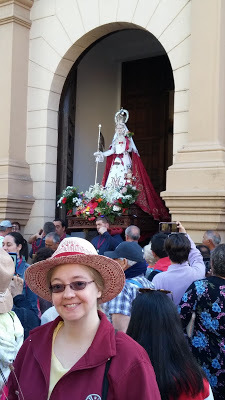 The first programmed stop was just outside the Fair Gate. The Virgen entered the Church of San Lázaro, prayers were said and reverences made, and she made a triumphal exit accompanied by music.
The first programmed stop was just outside the Fair Gate. The Virgen entered the Church of San Lázaro, prayers were said and reverences made, and she made a triumphal exit accompanied by music.Fernando said when he used to do the romería as a kid, only "four cats" would show up. That's the Spanish way of exaggerating to say "nobody." Monday, the street near San Antolín was crammed with people, more people watched from their balconies, and more and more people joined the parade as it wended out of Zamora. It was truly a community affair. I saw people from my choir, a former student played in one of the bands, and Fernando was constantly running into people he knew.
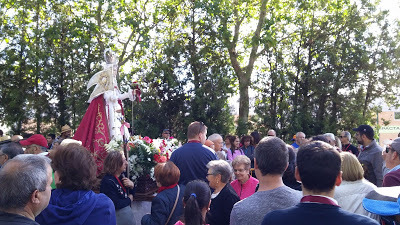 By 9:30, we'd already arrived at the Cross of Don Sancho, a little wooded area where the procession stopped and prayers were said.
By 9:30, we'd already arrived at the Cross of Don Sancho, a little wooded area where the procession stopped and prayers were said. 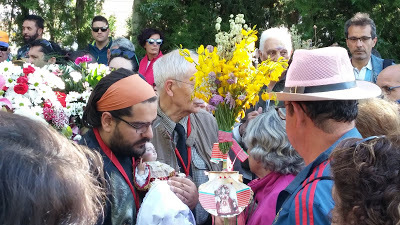 Then a couple of the brotherhood members ceremoniously unchained Christ from his mother and cradled him reverently for the faithful to come and kiss his feet. Given that I'm not Catholic and Fernando is lapsed (apostate, he says), we only watched. At this point, though we didn't realize it, Christ was taken ahead by car.
Then a couple of the brotherhood members ceremoniously unchained Christ from his mother and cradled him reverently for the faithful to come and kiss his feet. Given that I'm not Catholic and Fernando is lapsed (apostate, he says), we only watched. At this point, though we didn't realize it, Christ was taken ahead by car.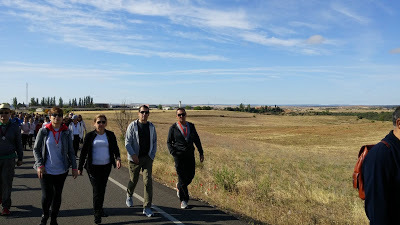 We passed the sign that indicated we were leaving Zamora and broke out into open country. I admit to getting a thrill for doing that on foot. I've only ever seen those signs from cars before. Sadly, the landscape looks almost as dry as it did when I first arrived in 2017. Last year, it must've looked much greener after a lot of refreshing spring rain we didn't get this year.
We passed the sign that indicated we were leaving Zamora and broke out into open country. I admit to getting a thrill for doing that on foot. I've only ever seen those signs from cars before. Sadly, the landscape looks almost as dry as it did when I first arrived in 2017. Last year, it must've looked much greener after a lot of refreshing spring rain we didn't get this year.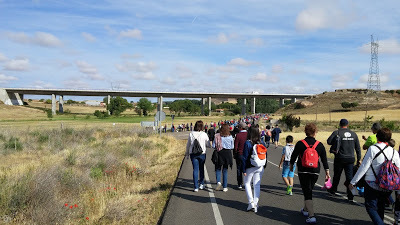 We were able to keep up a brisk pace, and the day was clear but not hot. The highway was closed to automobile traffic, which made for a lot of peace of mind. Red poppies lined the highway.
We were able to keep up a brisk pace, and the day was clear but not hot. The highway was closed to automobile traffic, which made for a lot of peace of mind. Red poppies lined the highway.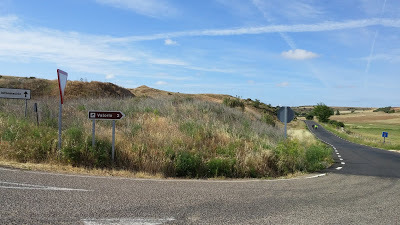 The fork leading to the route back if you stay with the procession all day We came up on the refreshments stop less than fifteen minutes after leaving the Cross of Don Sancho. The free "lemonade" was an insipid red liquid I chose not to do more than taste because restrooms were clearly going to be scarce. Fernando had brought roasted peanuts, and we walked and shelled them, shooting the breeze under the protection of hats.
The fork leading to the route back if you stay with the procession all day We came up on the refreshments stop less than fifteen minutes after leaving the Cross of Don Sancho. The free "lemonade" was an insipid red liquid I chose not to do more than taste because restrooms were clearly going to be scarce. Fernando had brought roasted peanuts, and we walked and shelled them, shooting the breeze under the protection of hats.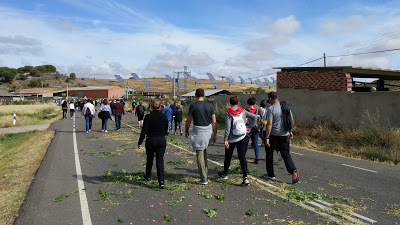 We entered industrial farmland, and considerate farmers had laid down carpets of rose petals and rosemary to attenuate the "fresh" smell of animals.
We entered industrial farmland, and considerate farmers had laid down carpets of rose petals and rosemary to attenuate the "fresh" smell of animals.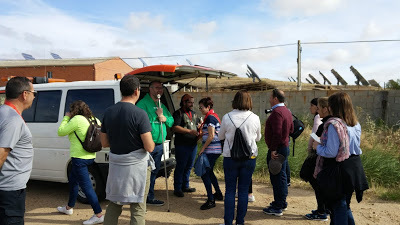 At 10:30, we came across an informal stop. "What are they giving out there?" asked Fernando. We looked closer, and it was the car with Christ. They'd stopped to allow for more foot kissing and claimed that donations were welcome. For the brotherhood, of course. I thought it was highly amusing.
At 10:30, we came across an informal stop. "What are they giving out there?" asked Fernando. We looked closer, and it was the car with Christ. They'd stopped to allow for more foot kissing and claimed that donations were welcome. For the brotherhood, of course. I thought it was highly amusing.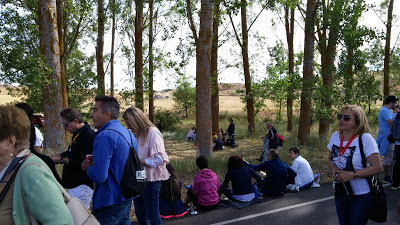 Only a little farther on, large groups of people were sitting by the side of the road, eating sandwiches and other second-breakfast items they'd brought. They likely knew exactly how little room there was to do this kind of thing in La Hiniesta.
Only a little farther on, large groups of people were sitting by the side of the road, eating sandwiches and other second-breakfast items they'd brought. They likely knew exactly how little room there was to do this kind of thing in La Hiniesta.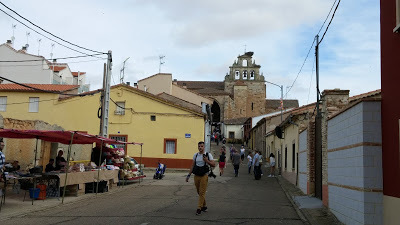
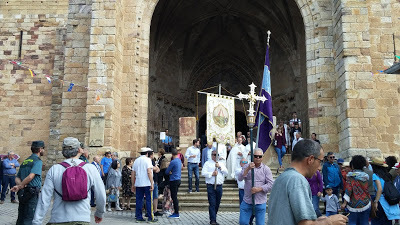 When we arrived ahead of the procession at the entrance to the village at about 11, we found a place set up with barriers where the action would clearly take place. I said I needed to get a look at the church before it was overrun with pilgrims. We hotfooted it to the center of town and made it just in time to see the Brotherhood of La Hiniesta leaving to meet the Virgen de la Concha at her arrival.
When we arrived ahead of the procession at the entrance to the village at about 11, we found a place set up with barriers where the action would clearly take place. I said I needed to get a look at the church before it was overrun with pilgrims. We hotfooted it to the center of town and made it just in time to see the Brotherhood of La Hiniesta leaving to meet the Virgen de la Concha at her arrival.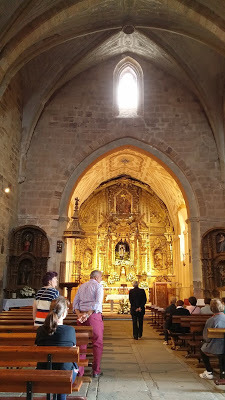 The church, one of the few pieces of Gothic architecture in Zamora province, is spectacular. The grand doorway has the ball decorations no one can tell by sight alone whether they are Romanesque or Isabelline Gothic. In this case, history shows us they are Isabelline. The interior is a single nave with impressive Baroque pieces and three fine Gothic statues. We read that there were Gothic paintings, but didn't find them. They may have been behind the main altar.
The church, one of the few pieces of Gothic architecture in Zamora province, is spectacular. The grand doorway has the ball decorations no one can tell by sight alone whether they are Romanesque or Isabelline Gothic. In this case, history shows us they are Isabelline. The interior is a single nave with impressive Baroque pieces and three fine Gothic statues. We read that there were Gothic paintings, but didn't find them. They may have been behind the main altar.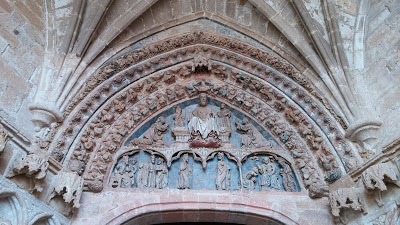 The main event is the facade. It's packed with masterful Gothic sculpture you simply don't expect in Zamora, highlighted by colorful paint.
The main event is the facade. It's packed with masterful Gothic sculpture you simply don't expect in Zamora, highlighted by colorful paint.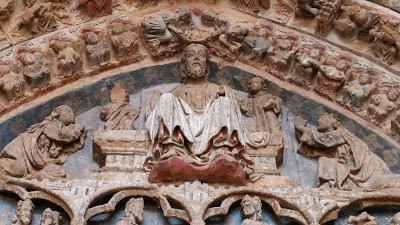 Being Gothic, the scenes are all strictly religious, illustrating the life of Christ. But I could've stared at the sinuous, expressive forms for much longer than the three minutes we spared before running back to meet the procession. Looking at the photos, I dare say this Gothic style is influenced by the Romanesque symmetry all around the province.
Being Gothic, the scenes are all strictly religious, illustrating the life of Christ. But I could've stared at the sinuous, expressive forms for much longer than the three minutes we spared before running back to meet the procession. Looking at the photos, I dare say this Gothic style is influenced by the Romanesque symmetry all around the province.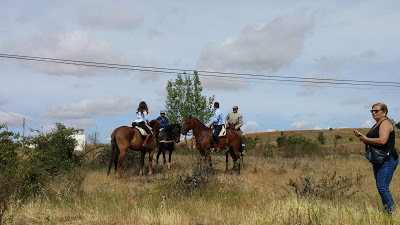 Horses weren't allowed to participate in the ceremonies this year,
Horses weren't allowed to participate in the ceremonies this year, but they came to watch.
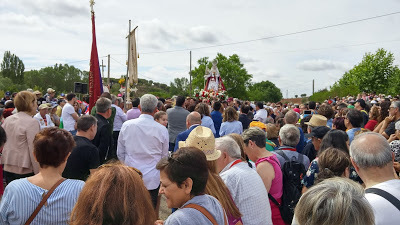 Back at the entrance, we got a pretty good spot to watch the arrival of the Virgen. The brotherhood members intoned a song. A couple of children doing their first communion read poems including the phrase "I will never forget this day." The mayors of Zamora and La Hiniesta traded the canes that are the symbol of their responsibilities. They trade them back after the mass, before the procession heads back to Zamora.
Back at the entrance, we got a pretty good spot to watch the arrival of the Virgen. The brotherhood members intoned a song. A couple of children doing their first communion read poems including the phrase "I will never forget this day." The mayors of Zamora and La Hiniesta traded the canes that are the symbol of their responsibilities. They trade them back after the mass, before the procession heads back to Zamora.What everyone wanted to see was this, the dance of the brotherhoods' flags.
Then we processed again, to the church!
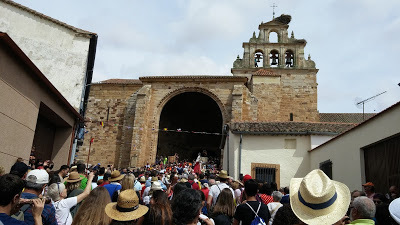
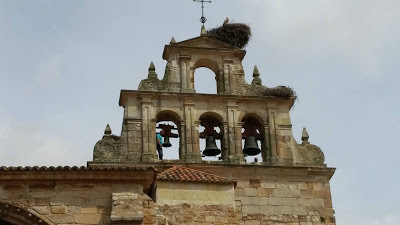 Ringing the bells
Ringing the bells
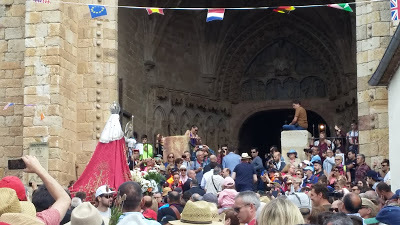 The Virgen made a circuit of the whole church, accompanied by the bands and the bellringers, before making a triumphal entry. Not nearly all the pilgrims would fit into the church for the solemn mass, and it seemed as though most didn't try.
The Virgen made a circuit of the whole church, accompanied by the bands and the bellringers, before making a triumphal entry. Not nearly all the pilgrims would fit into the church for the solemn mass, and it seemed as though most didn't try.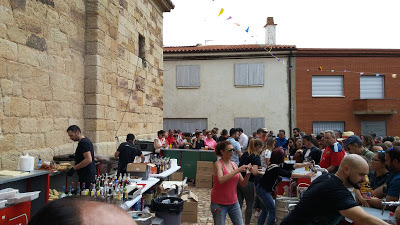 Fernando said in the old days, plenty of the town's bars were open to provide restrooms and refreshments to the pilgrims. This time, only an outdoor events place was open--right on the side of the church. They were doing excellent business. Something must've happened over the years to make the local bars give up, because absolutely nothing was open. If not for the thousands of pilgrims, La Hiniesta would've been a ghost town.
Fernando said in the old days, plenty of the town's bars were open to provide restrooms and refreshments to the pilgrims. This time, only an outdoor events place was open--right on the side of the church. They were doing excellent business. Something must've happened over the years to make the local bars give up, because absolutely nothing was open. If not for the thousands of pilgrims, La Hiniesta would've been a ghost town.One of my devious roommate's ideas for not having to walk back to Zamora was to limp, moaning, into the Red Cross tent, and keep up the act until they take you home in an ambulance. There was no way I was doing that, but the Red Cross had port-a-potties, for which I will be eternally grateful. At about 1 p.m., after an incredible morning, and having our photo taken by someone else Fernando knew, we were confronted with this:
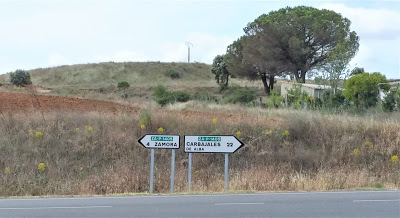 Four kilometers back to Zamora, plus the kilometers from the city limit to our house. On foot. Although the day was fine for walking, the return was tiresome because the highway was now open to traffic and, importantly, it was getting close to time for the midday meal.
Four kilometers back to Zamora, plus the kilometers from the city limit to our house. On foot. Although the day was fine for walking, the return was tiresome because the highway was now open to traffic and, importantly, it was getting close to time for the midday meal.We started toward Zamora, and Fernando tried what had always worked before: hitchhiking. "Nobody really hitchhikes anymore, do they?" he said after seven or eight attempts, echoing something I'd said earlier. Then we saw someone carrying an oboe wave down what was obviously a prearranged ride.
"He has a ride," I said, and we ran up the road a way. After they'd turned around, Fernando's trusty thumb finally worked.
Riding with one of the musicians afforded us a conversation about how much the romería has changed and a comment about the way the mayors exchange canes. "Just think, the Mayor of La Hiniesta could make a decree during those few hours and Zamorans would have to live by it!"
And we made it home in time for the midday meal after a nice shower. It was hard to believe the rest of the world, and even the rest of Spain, had been going about normal business on this extraordinary day, the day of the romería to La Hiniesta.
Published on June 11, 2019 15:30
May 31, 2019
Zamora's Medieval Treasures: Santiago de los Caballeros
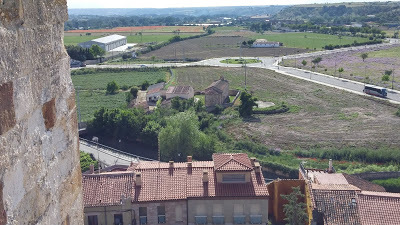 Santiago de los Caballeros in the middle of the Field of Truth,
Santiago de los Caballeros in the middle of the Field of Truth, seen from the castle
Photos in this post 2017, 2018, 2019 Jessica Knauss When you visit Zamora, you're likely to see Santiago de los Caballeros for the first time as you gaze down at the Field of Truth from the eleventh-century city walls or the ruins of the castle. I sometimes take a little walk to get this this view and marvel that I live here. In this post, I'm sharing the oldest Romanesque structure in the city in order to celebrate my assignment to the same school in Zamora for next school year. (Three in a row! That's the longest I've stayed anywhere in decades!)
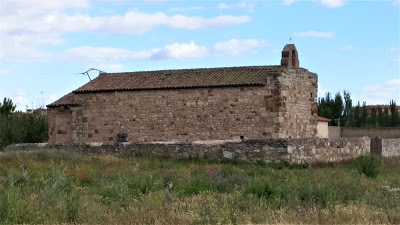 It's known as St. James of the Knights because throughout the Middle Ages, this was where squires came to do a nightlong vigil and be knighted in a ceremony the following day. The current structure has elements from the beginning of the twelfth century. The rudimentary north and western facades (seen above) are likely hasty reconstructions from the late twelfth century and later. Like other Romanesque churches here, it's made from lovely golden and rose-colored local stones. From afar, it looks small, an impression that doesn't change as you come closer.
It's known as St. James of the Knights because throughout the Middle Ages, this was where squires came to do a nightlong vigil and be knighted in a ceremony the following day. The current structure has elements from the beginning of the twelfth century. The rudimentary north and western facades (seen above) are likely hasty reconstructions from the late twelfth century and later. Like other Romanesque churches here, it's made from lovely golden and rose-colored local stones. From afar, it looks small, an impression that doesn't change as you come closer.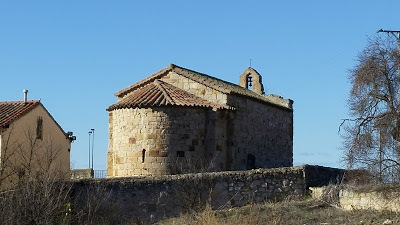 Santiago's "good side" has the intact early twelfth-century apse. The most famous knight to undergo the vigil and ceremony on this site was Ruy Díaz de Vivar, later known as El Cid (c. 1043 - 1099). A visit to Santiago de los Caballeros is a stroll through history and legend. To keep it short, it's said that after he discovered his king, Sancho I, had been assassinated, El Cid chased the murderer, Bellido Dolfos, from the Door of Loyalty (previously the Door of Betrayal) in the city wall near the castle into the field where Santiago de los Caballeros sits. There, El Cid apprehended Bellido Dolfos, and the open area has been called the Field of Truth ever since.
Santiago's "good side" has the intact early twelfth-century apse. The most famous knight to undergo the vigil and ceremony on this site was Ruy Díaz de Vivar, later known as El Cid (c. 1043 - 1099). A visit to Santiago de los Caballeros is a stroll through history and legend. To keep it short, it's said that after he discovered his king, Sancho I, had been assassinated, El Cid chased the murderer, Bellido Dolfos, from the Door of Loyalty (previously the Door of Betrayal) in the city wall near the castle into the field where Santiago de los Caballeros sits. There, El Cid apprehended Bellido Dolfos, and the open area has been called the Field of Truth ever since.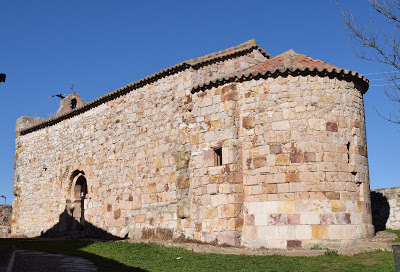 When I pointed out Santiago de los Caballeros and its connections to the famous hero, my friend said, "I didn't know El Cid was in Zamora." Come on, the first half of the El Cid film takes place in Zamora! Zamora, an open secret of spectacular history.
When I pointed out Santiago de los Caballeros and its connections to the famous hero, my friend said, "I didn't know El Cid was in Zamora." Come on, the first half of the El Cid film takes place in Zamora! Zamora, an open secret of spectacular history.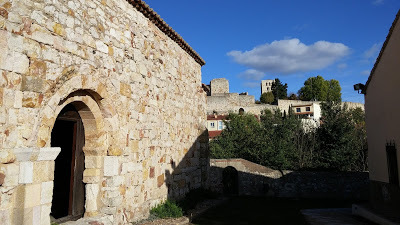 Santiago de los Caballeros below the castle and cathedral bell tower
Santiago de los Caballeros below the castle and cathedral bell tower
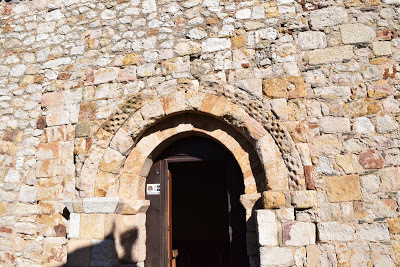 In spite of its illustrious past, Santiago de los Caballeros gives off an air of humility today. Its placement near the river has exposed it to repeated flooding and continual repair. It seems each time it was repaired, the more basic the construction. The only decoration left to the twelfth-century entrance is that Romanesque predilection, a checkerboard pattern.
In spite of its illustrious past, Santiago de los Caballeros gives off an air of humility today. Its placement near the river has exposed it to repeated flooding and continual repair. It seems each time it was repaired, the more basic the construction. The only decoration left to the twelfth-century entrance is that Romanesque predilection, a checkerboard pattern.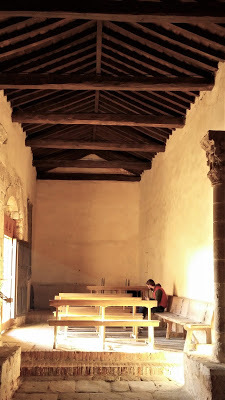 That's the caretaker. Stepping inside, the small space creates intimacy. When the door is left open, it's more than enough to flood the space with light. It has two levels of floor, surely the result of building works at different points of sedimentary history. Both levels have medieval tombs under them.
That's the caretaker. Stepping inside, the small space creates intimacy. When the door is left open, it's more than enough to flood the space with light. It has two levels of floor, surely the result of building works at different points of sedimentary history. Both levels have medieval tombs under them.Looking toward the foot, picture the plaster-covered walls replete with colorful paintings and you'll have a better idea of what Santiago was like when it was first built and used.
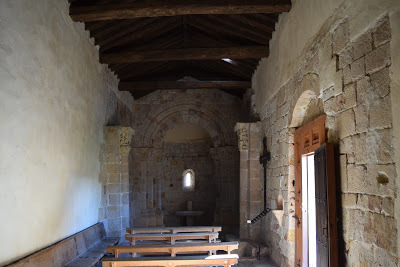 The lack of features in the rest of the building puts the focus on the parts that come to us directly from the early twelfth century: columns that might once have supported an arch, complete with capitals that are unique in Zamora; a triumphal arch some critics have said looks more like a doorway; and the tiny semicircular apse.
The lack of features in the rest of the building puts the focus on the parts that come to us directly from the early twelfth century: columns that might once have supported an arch, complete with capitals that are unique in Zamora; a triumphal arch some critics have said looks more like a doorway; and the tiny semicircular apse.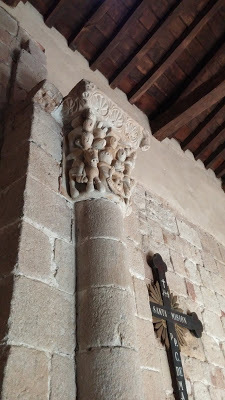 As usual, the meaty art is in the column capitals. The two large capitals before the apse both have simas with leaves, vines, and compressed palms not unlike the ones in San Claudio de Olivares. Many critics believe this is Asturian influence. To my eyes, it looks like a natural continuation of the sima tradition seen first in San Pedro de la Nave.
As usual, the meaty art is in the column capitals. The two large capitals before the apse both have simas with leaves, vines, and compressed palms not unlike the ones in San Claudio de Olivares. Many critics believe this is Asturian influence. To my eyes, it looks like a natural continuation of the sima tradition seen first in San Pedro de la Nave.This first capital is worth viewing from every angle, such is the inscrutable confusion of forms.
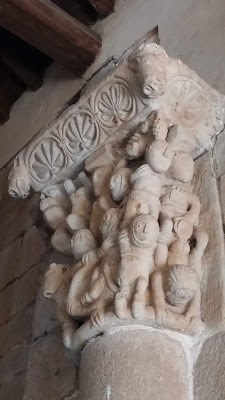 Every interpretation I've read claims that this is a sculptural representation of Hell, complete with all manner of fornication. Is it Hell, or the earthly behavior that leads to that low place? Before reading about this capital, I thought it was acrobats, a popular subject in Romanesque sculpture with multiple interpretations. Given the chaotic nature of the composition, it's likely the most negative connotations are the correct ones. Acrobats could indeed represent sins of the flesh, but looking closer, the sins appear to be represented literally.
Every interpretation I've read claims that this is a sculptural representation of Hell, complete with all manner of fornication. Is it Hell, or the earthly behavior that leads to that low place? Before reading about this capital, I thought it was acrobats, a popular subject in Romanesque sculpture with multiple interpretations. Given the chaotic nature of the composition, it's likely the most negative connotations are the correct ones. Acrobats could indeed represent sins of the flesh, but looking closer, the sins appear to be represented literally.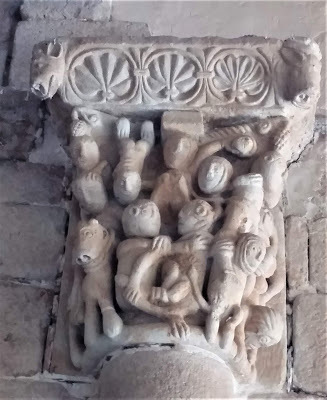 The inclusion of a horse on the side and heads of oxen in the sima further emphasize the theme of humans committing the sin of surrendering to their animal nature. I adore the numerous faces, the honest execution, and the inventiveness of the forms. Call me lurid, but this may be my favorite capital in Zamora.
The inclusion of a horse on the side and heads of oxen in the sima further emphasize the theme of humans committing the sin of surrendering to their animal nature. I adore the numerous faces, the honest execution, and the inventiveness of the forms. Call me lurid, but this may be my favorite capital in Zamora.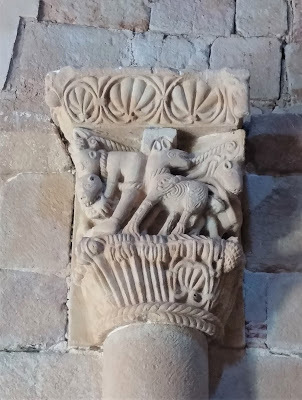 Some Romanesque churches like to balance out the themes in their capitals by portraying opposite concepts across the aisle. Not so here. Clearly done by the same delightful artist, this capital shows the consequences of the actions in the first. The flames of Hell rise out of an Asturian-inspired rope decoration. Ropes are a continued theme as the tortured souls appear to be tied to the exotic beasts that punish them, with obvious allegorical value.
Some Romanesque churches like to balance out the themes in their capitals by portraying opposite concepts across the aisle. Not so here. Clearly done by the same delightful artist, this capital shows the consequences of the actions in the first. The flames of Hell rise out of an Asturian-inspired rope decoration. Ropes are a continued theme as the tortured souls appear to be tied to the exotic beasts that punish them, with obvious allegorical value.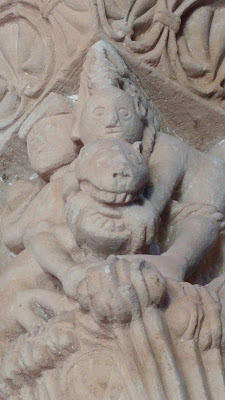 This poor fellow appears to be giving his tormentor a hug while it gnaws his hands off. This particular scene could have a subconnotation of the way time consumes all living things. But time is hardly a factor when you're enduring the eternal torments of the damned.
This poor fellow appears to be giving his tormentor a hug while it gnaws his hands off. This particular scene could have a subconnotation of the way time consumes all living things. But time is hardly a factor when you're enduring the eternal torments of the damned. 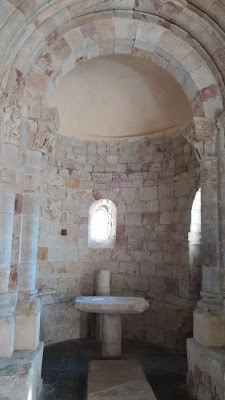 Turning our attention to the apse, the semicircular arch over the quadrilateral structure of the columns makes a perfect metaphor for the union between heaven and earth. The semicircular apse has three small windows and a stone checkerboard border. A simple table altar stands over the Renaissance tomb of one of Zamora's bishops. It would be hard to cram more sacredness into this limited space. During one of my visits here, I found this view to be as useful to a meditative state as a view of nature.
Turning our attention to the apse, the semicircular arch over the quadrilateral structure of the columns makes a perfect metaphor for the union between heaven and earth. The semicircular apse has three small windows and a stone checkerboard border. A simple table altar stands over the Renaissance tomb of one of Zamora's bishops. It would be hard to cram more sacredness into this limited space. During one of my visits here, I found this view to be as useful to a meditative state as a view of nature.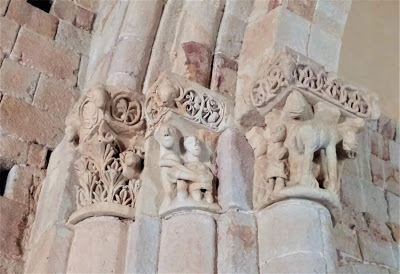 The triumphal arch has three fractional columns on each side, and their capitals line up in a row. On the left, delicately carved plant decorations that echo the simas, Adam and Eve after the original sin with the Serpent winding around them like a boa constrictor, and the expulsion from Eden.
The triumphal arch has three fractional columns on each side, and their capitals line up in a row. On the left, delicately carved plant decorations that echo the simas, Adam and Eve after the original sin with the Serpent winding around them like a boa constrictor, and the expulsion from Eden.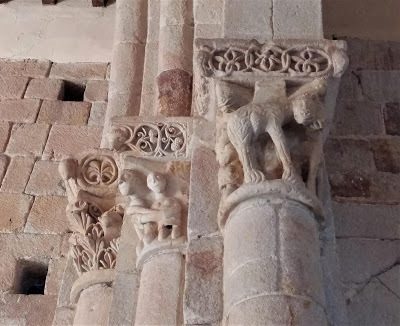 The Adam and Eve figures are strange and rudimentary, but the serpent symbolism is original. In this view, we see the other side of the expulsion capital, which has facing lions. Remember them.
The Adam and Eve figures are strange and rudimentary, but the serpent symbolism is original. In this view, we see the other side of the expulsion capital, which has facing lions. Remember them.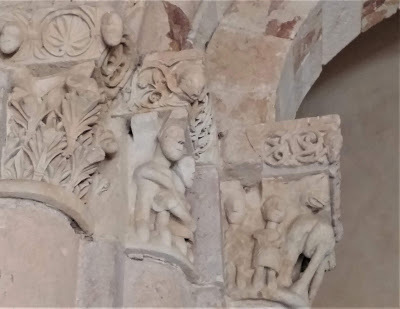 What's left of Adam and Eve in the expulsion from Eden is again crudely executed, in the same style as the serpent capital. Rather than merely covering themselves with found objects, however, we can see Eve is wearing a tunic that, while basic, doesn't have to be held together with the hands. She still modestly crosses her arms in front.
What's left of Adam and Eve in the expulsion from Eden is again crudely executed, in the same style as the serpent capital. Rather than merely covering themselves with found objects, however, we can see Eve is wearing a tunic that, while basic, doesn't have to be held together with the hands. She still modestly crosses her arms in front.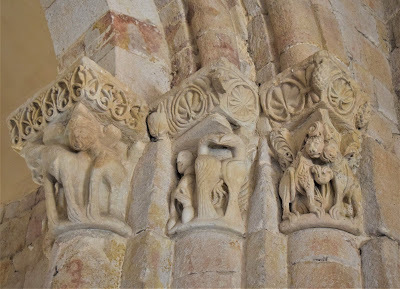 On the opposite side, the same artist placed indistinct four-legged beasts, facing birds and a man, and facing lions in a jungle-like scene. The enigmatic man appears to be protected by the birds, barely visible behind them. Birds can be representations of the human soul, or they can protect the human soul, which is sometimes symbolized with an anonymous human being. I like this interpretation because the man's pleasant expression indicates he has no worries: these birds are protecting him.
On the opposite side, the same artist placed indistinct four-legged beasts, facing birds and a man, and facing lions in a jungle-like scene. The enigmatic man appears to be protected by the birds, barely visible behind them. Birds can be representations of the human soul, or they can protect the human soul, which is sometimes symbolized with an anonymous human being. I like this interpretation because the man's pleasant expression indicates he has no worries: these birds are protecting him.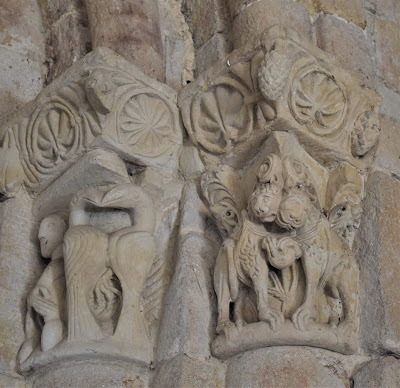 The lions in this group are the best sculptures in the church. The lions on the other side appear to be rough drafts, and these the final development. Here we can see why the lion came to be called "king of the jungle." But the leaves and branches here aren't meant to represent just any plant. These lions are guarding the Tree of Life. Nobody's getting past those fearsome claws!
The lions in this group are the best sculptures in the church. The lions on the other side appear to be rough drafts, and these the final development. Here we can see why the lion came to be called "king of the jungle." But the leaves and branches here aren't meant to represent just any plant. These lions are guarding the Tree of Life. Nobody's getting past those fearsome claws!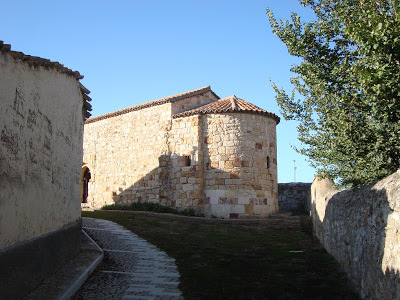 Santiago de los Caballeros is in use today. It's served by the same priest who gives mass in neighboring San Claudio de Olivares. It has endured the ravages of weather for about 900 years. For two years, I've had the honor of sharing space with it. Let's see how much longer we both last!
Santiago de los Caballeros is in use today. It's served by the same priest who gives mass in neighboring San Claudio de Olivares. It has endured the ravages of weather for about 900 years. For two years, I've had the honor of sharing space with it. Let's see how much longer we both last!
Published on May 31, 2019 09:05
May 15, 2019
A Lonely Place Made Sacred by Architecture and Paint: Medieval Soria
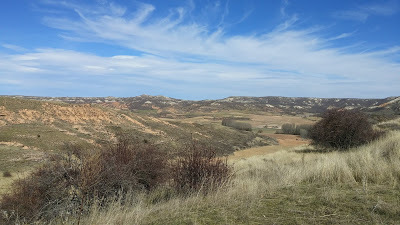 Looking for history in the middle of nowhere.
Looking for history in the middle of nowhere.Photos in this post 2019 Jessica Knauss Our epic journey through the province of Soria in early March meant Daniel and I were often confronted with vast expanses of rolling Castilian plains. Sometimes, if you subtracted the asphalt roads, you would've been left with no sign of human life at any point in history--unless you knew exactly where to look.
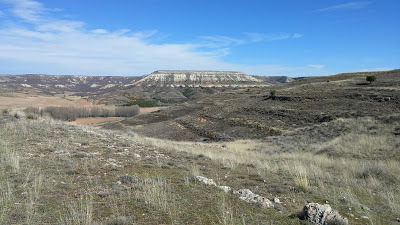 Daniel had designed the itinerary so that the Church of San Baudelio near Casillas de Berlanga would dominate one of the trip days. As usual, though, there was too much to see! I'm thrilled we didn't skip Almazán, but taking that tour meant we had to rush to San Baudelio before it closed for the day. It seemed as if we would never make it, as there was never any indication that we were getting closer to this magical building. It was first started as a hermitage in the middle of nowhere. You can't get more nowhere than Casillas de Berlanga--no offense intended.
Daniel had designed the itinerary so that the Church of San Baudelio near Casillas de Berlanga would dominate one of the trip days. As usual, though, there was too much to see! I'm thrilled we didn't skip Almazán, but taking that tour meant we had to rush to San Baudelio before it closed for the day. It seemed as if we would never make it, as there was never any indication that we were getting closer to this magical building. It was first started as a hermitage in the middle of nowhere. You can't get more nowhere than Casillas de Berlanga--no offense intended.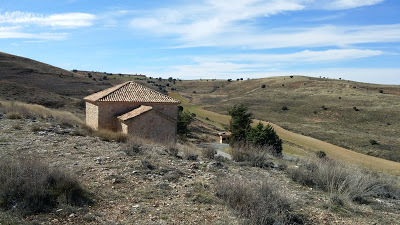 The tiny box of a building (less than 10 square meters) that appears between hillocks as if conjured by a Spanish Merlin is often described as plain. Although I didn't get a chance to read about the architecture before the visit, the sight of the stones taken from the hillside where it sits and lots of medieval concrete resonated strongly with me. Indeed, as I read later, it is believed this church was erected shortly after this area was "reconquered" in the year 912. Which is to say that the structure is pre-Romanesque Mozarabic. This building was around, looking much as it does today, when the characters in Seven Noble Knights lived, fought, and loved.
The tiny box of a building (less than 10 square meters) that appears between hillocks as if conjured by a Spanish Merlin is often described as plain. Although I didn't get a chance to read about the architecture before the visit, the sight of the stones taken from the hillside where it sits and lots of medieval concrete resonated strongly with me. Indeed, as I read later, it is believed this church was erected shortly after this area was "reconquered" in the year 912. Which is to say that the structure is pre-Romanesque Mozarabic. This building was around, looking much as it does today, when the characters in Seven Noble Knights lived, fought, and loved.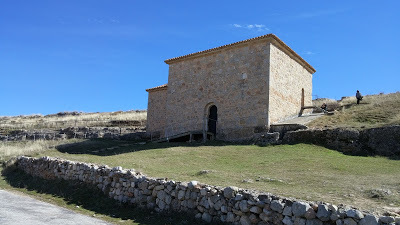
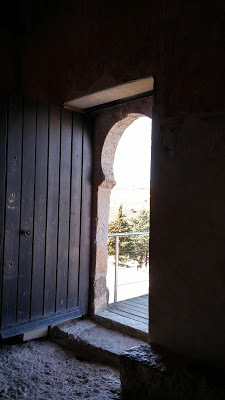 As if that history weren't enough to give me the authorial tingles, we hurried inside to make the most of the time before the caretaker closed up. I had to take off my glasses because the transition lenses made it impossible to see anything in the light from three tiny windows and the caretaker was answering the questions of three or four visitors with their modern speech, clothes, and priorities.
As if that history weren't enough to give me the authorial tingles, we hurried inside to make the most of the time before the caretaker closed up. I had to take off my glasses because the transition lenses made it impossible to see anything in the light from three tiny windows and the caretaker was answering the questions of three or four visitors with their modern speech, clothes, and priorities.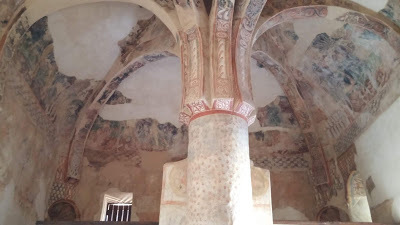 In spite of all that, the interior overwhelmed me with a sense of sacred awe. To go against my usual writing style and employ understatement, this is no ordinary tiny hillside hermitage. There is no other building like this in all the world.
In spite of all that, the interior overwhelmed me with a sense of sacred awe. To go against my usual writing style and employ understatement, this is no ordinary tiny hillside hermitage. There is no other building like this in all the world.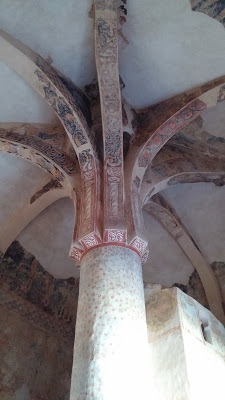 As you walk in, you're confronted by a column that seems enormous because it draws the eye up and fills the field of vision. Eight fronds arc out at the top to complete a cupola that covers the entire space, encompassing it and all visitors within what would be the shade of this metaphorical palm tree. That's right, as you walk in, you face the Tree of Life, the Source of everything, physical and spiritual.
As you walk in, you're confronted by a column that seems enormous because it draws the eye up and fills the field of vision. Eight fronds arc out at the top to complete a cupola that covers the entire space, encompassing it and all visitors within what would be the shade of this metaphorical palm tree. That's right, as you walk in, you face the Tree of Life, the Source of everything, physical and spiritual.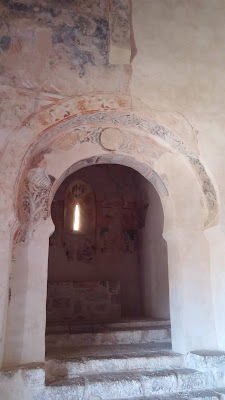 To the left of the entrance, so small you might miss it, a diminutive apse opens up with double horseshoe arches and lets light in with its small window. Here, the most sacred ceremonies, such as consecration, would have been carried out without the need for any congregation to witness. Only about four people can fit there with room to move.
To the left of the entrance, so small you might miss it, a diminutive apse opens up with double horseshoe arches and lets light in with its small window. Here, the most sacred ceremonies, such as consecration, would have been carried out without the need for any congregation to witness. Only about four people can fit there with room to move.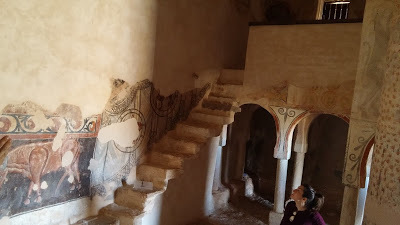 In the center, an open space harbors altar tables and a stairway to the most unusual part of the building, the loft.
In the center, an open space harbors altar tables and a stairway to the most unusual part of the building, the loft.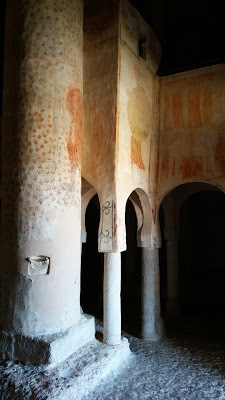
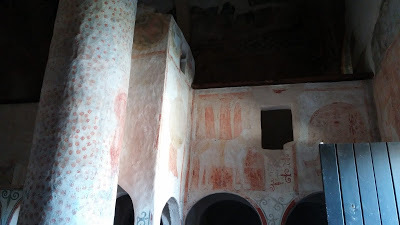 The loft enjoys a small window and a tiny chapel with room for only one person and its own two Mozarabic windows with horseshoe arches at the top. The loft is not accessible to the public, but it is clearly a place for contemplative isolation. The feature that makes this church unique also lends it tremendous spiritual gravity.
The loft enjoys a small window and a tiny chapel with room for only one person and its own two Mozarabic windows with horseshoe arches at the top. The loft is not accessible to the public, but it is clearly a place for contemplative isolation. The feature that makes this church unique also lends it tremendous spiritual gravity.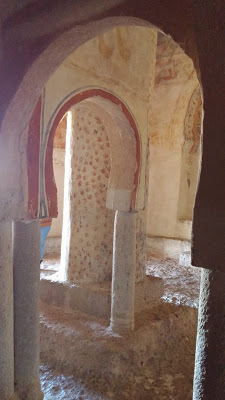
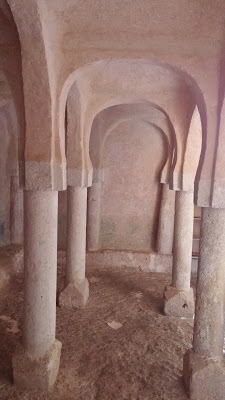 The loft is supported by a forest of miniature columns that come together in eleven horseshoe arches without capitals. Known as the "mosque," this collection of architecture only rises to a third of the building's height. It provides a daunting barrier between the rest of the building and the original hermitage cave entrance.
The loft is supported by a forest of miniature columns that come together in eleven horseshoe arches without capitals. Known as the "mosque," this collection of architecture only rises to a third of the building's height. It provides a daunting barrier between the rest of the building and the original hermitage cave entrance. 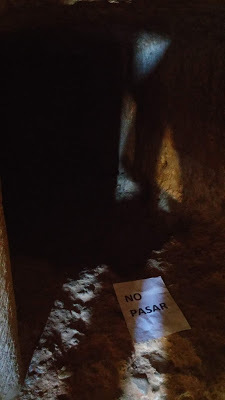 My fantastic photo of the cave entrance.
My fantastic photo of the cave entrance.Don't go in, the paper emphatically instructs.
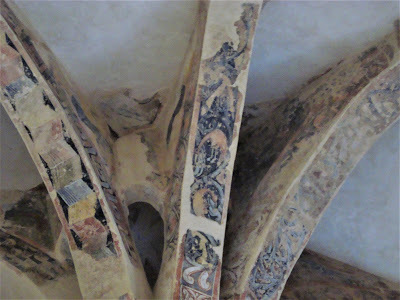 Having taken in all that uniqueness, it's time to look up at the top of the palm tree again. Notice the hole between the branches. You think you're imagining it, but you can kind of see something architectural going on inside. You're not imagining it! There's a secret chamber up there! It's impractical to access and evokes the unstable border region this was when San Baudelio was built. Would it have been a place to hide valuables or even a hermit in case of attack?
Having taken in all that uniqueness, it's time to look up at the top of the palm tree again. Notice the hole between the branches. You think you're imagining it, but you can kind of see something architectural going on inside. You're not imagining it! There's a secret chamber up there! It's impractical to access and evokes the unstable border region this was when San Baudelio was built. Would it have been a place to hide valuables or even a hermit in case of attack?My descriptions and photos are falling short. The wonder San Baudelio induces is untranslatable.
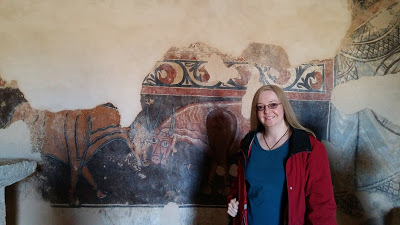 These bulls are the original finished paintings!
These bulls are the original finished paintings!Photo 2019 Daniel Sanz And as you can see in the photos, there's still more to marvel at. We'd originally come for the extensive medieval paintings, as many guidebooks call this Soria's "Sistine Chapel." In accordance with medieval sensibilities, the artists among this community of monks left no space plain. They used a technique similar to fresco, so that the paint penetrates deep into the wall. In the early twentieth century, the outermost layers of some paintings were sold and removed. After some back and forth, these works of art can now be viewed in person in Madrid and New York. I'd seen them already in the museums and loved them with no knowledge of where they came from. There is nothing like viewing this art in its original context.
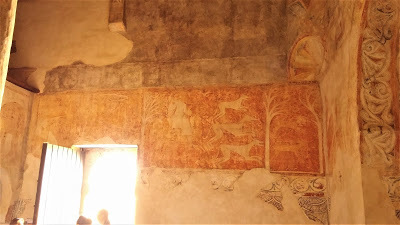 I remember seeing this rabbit hunting scene in the Museo del Prado in 2005. The imprints left behind are still so vivid, the visitor gets most of the intended impact. The central column is dotted to suggest a palm trunk. The branches are covered in colorful geometric and architectural patterns with long-necked birds that call San Pedro de la Nave to mind.
I remember seeing this rabbit hunting scene in the Museo del Prado in 2005. The imprints left behind are still so vivid, the visitor gets most of the intended impact. The central column is dotted to suggest a palm trunk. The branches are covered in colorful geometric and architectural patterns with long-necked birds that call San Pedro de la Nave to mind.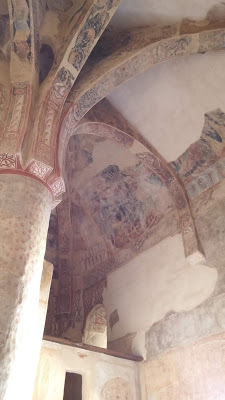 The higher areas and loft feature remnants of Biblical scenes with people and tables.
The higher areas and loft feature remnants of Biblical scenes with people and tables.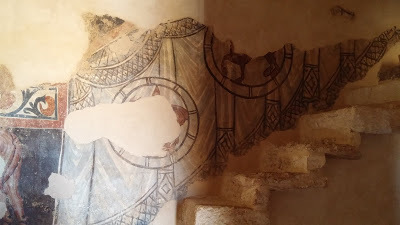 The area above the stairs has painted drapery and medallions with animal figures.
The area above the stairs has painted drapery and medallions with animal figures.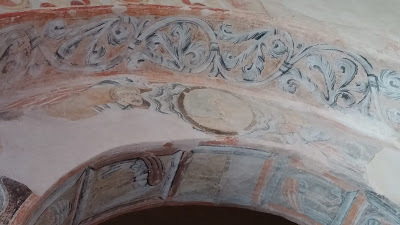 The entrance to the apse shows angels supporting a medallion with the Dextera Domini, the right hand of the Lord.
The entrance to the apse shows angels supporting a medallion with the Dextera Domini, the right hand of the Lord.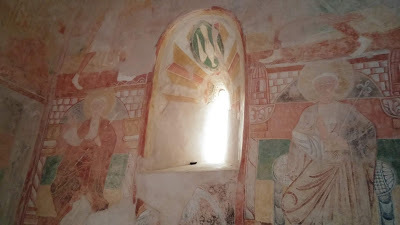
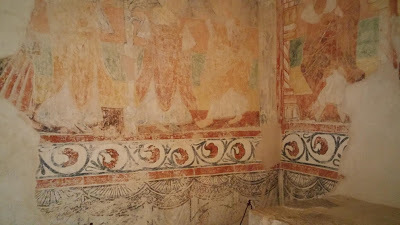 The apse is filled with saints and Biblical scenes and a dove, the Holy Spirit, springs forth from the window, as I'd seen in Maderuelo.
The apse is filled with saints and Biblical scenes and a dove, the Holy Spirit, springs forth from the window, as I'd seen in Maderuelo.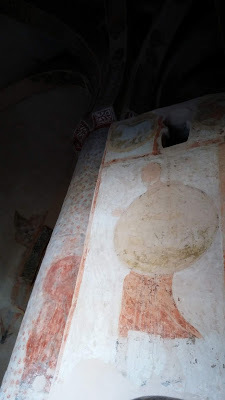 Warrior on the side of the loft chapel. During the visit, I was under the impression that all the paintings were Romanesque, from the eleventh century onward. But according to Jaime Cobreros, many discreet scenes may be from the earliest times of the church's existence, the tenth century. The possibly earlier paintings are less obviously religious in nature and show some artistic connection with Hispano-Muslim art and Beatus manuscript illustration. These include some lions; the hunting scene, a camel, a rampant greyhound, and the warrior with shield on the side of the loft chapel, all now in the Prado; and the magnificent bulls pictured above. I couldn't believe no one had bought the top layer of the bulls painting, and had Daniel take my photo with it so I could pretend it was mine.
Warrior on the side of the loft chapel. During the visit, I was under the impression that all the paintings were Romanesque, from the eleventh century onward. But according to Jaime Cobreros, many discreet scenes may be from the earliest times of the church's existence, the tenth century. The possibly earlier paintings are less obviously religious in nature and show some artistic connection with Hispano-Muslim art and Beatus manuscript illustration. These include some lions; the hunting scene, a camel, a rampant greyhound, and the warrior with shield on the side of the loft chapel, all now in the Prado; and the magnificent bulls pictured above. I couldn't believe no one had bought the top layer of the bulls painting, and had Daniel take my photo with it so I could pretend it was mine.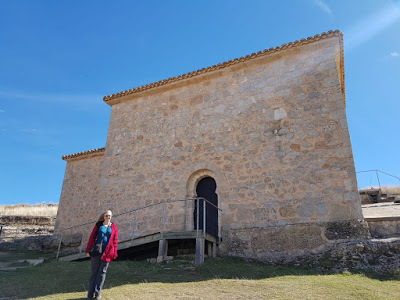 Photo 2019 Daniel Sanz Outside the church, you think, "All that is in there?"
Photo 2019 Daniel Sanz Outside the church, you think, "All that is in there?"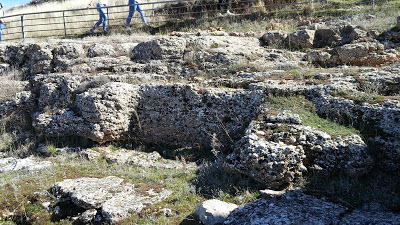 Then you take a look at the archaeological site of the medieval necropolis. Just outside the apse, they've found thirty sarcophagi from the eleventh to the thirteenth centuries that were probably used even a bit after that. Monks burying monks.
Then you take a look at the archaeological site of the medieval necropolis. Just outside the apse, they've found thirty sarcophagi from the eleventh to the thirteenth centuries that were probably used even a bit after that. Monks burying monks.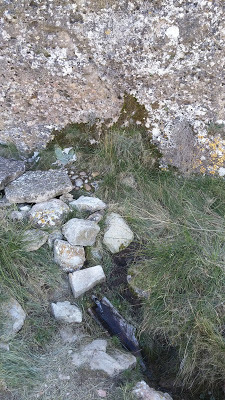 On the other side, there's a modest, modern spout that marks the spot where the first hermit found a water source so he could live out here all alone, and which was exploited by the monks who followed him.
On the other side, there's a modest, modern spout that marks the spot where the first hermit found a water source so he could live out here all alone, and which was exploited by the monks who followed him.We still have the building and paintings unaltered today because the church became neglected after the thirteenth century. No more monks wanted to live way out here, and so no one was around to make changes with new architectural fads.
And that was it. We enjoyed this unforgettable place for only about 40 minutes before the caretaker closed up. We had to leave to make it to our lunch reservation in Berlanga del Duero, in any case. The spirit is willing, but the flesh is weak!
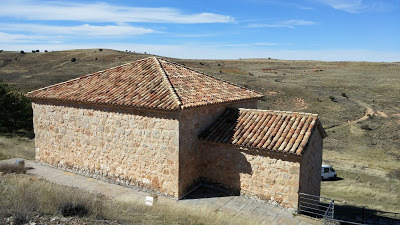 Our visit was similar to San Baudelio's history: a brief, shining artistic moment, never to be imitated anywhere else.
Our visit was similar to San Baudelio's history: a brief, shining artistic moment, never to be imitated anywhere else.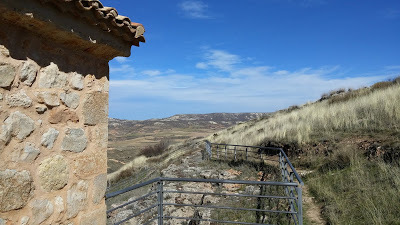 On the way home to Zamora, I was reading some of the pamphlets we picked up on this epic trip and discovered that in Berlanga del Duero, there's an entire museum devoted to San Baudelio. Sigh. Next time. Meanwhile, many scholars have published articles and photos on San Baudelio, as a simple internet search reveals. Daniel and I are far from the only San Baudelio nerds in the world.
On the way home to Zamora, I was reading some of the pamphlets we picked up on this epic trip and discovered that in Berlanga del Duero, there's an entire museum devoted to San Baudelio. Sigh. Next time. Meanwhile, many scholars have published articles and photos on San Baudelio, as a simple internet search reveals. Daniel and I are far from the only San Baudelio nerds in the world.
Published on May 15, 2019 15:31
May 9, 2019
Puebla de Sanabria: Untouched by Time
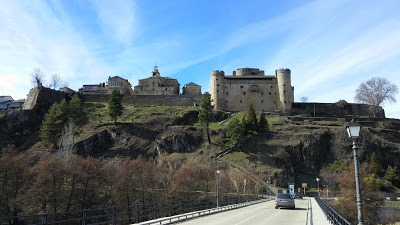 Puebla de Sanabria on its rocky outcrop over the Tera
Puebla de Sanabria on its rocky outcrop over the Tera juts into the tourist's imagination.
Photos in this post 2018 and 2019 Jessica Knauss It was the winter low season in Puebla de Sanabria, with no festivals or pilgrimages scheduled for months, but my traveling companion, Daniel, felt lucky to grab the last available one-star hotel room in the historical center. Puebla is one of the official Most Beautiful Villages in Spain, a France-inspired list that began in 2011 as a way to promote rural tourism. It’s working.
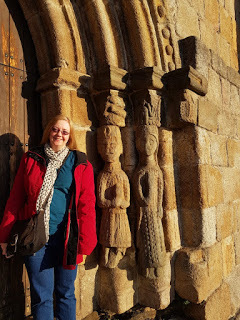 Still can't get inside.
Still can't get inside.Photo 2019 Daniel Sanz We’d come to see Romanesque buildings, but quickly found that the churches on my bucket list were closed for visits until Easter week. We were left with buying souvenirs or walking among the pristine streets to admire the popular architecture.
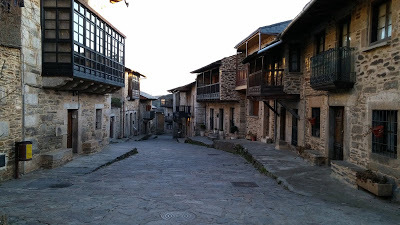 It wasn’t a bad consolation prize, because aside from the occasional car and a dragon-faced rainspout the residents couldn’t resist, the old town of Puebla looks as it must have in the sixteenth or seventeenth century. Tawny stones fit together in pleasant haphazard puzzles, noble crests adorn palaces, and extended eaves and colonnades provide shelter from wet weather. We aren’t the only visitors to get the sense that this is a place untouched by time.
It wasn’t a bad consolation prize, because aside from the occasional car and a dragon-faced rainspout the residents couldn’t resist, the old town of Puebla looks as it must have in the sixteenth or seventeenth century. Tawny stones fit together in pleasant haphazard puzzles, noble crests adorn palaces, and extended eaves and colonnades provide shelter from wet weather. We aren’t the only visitors to get the sense that this is a place untouched by time.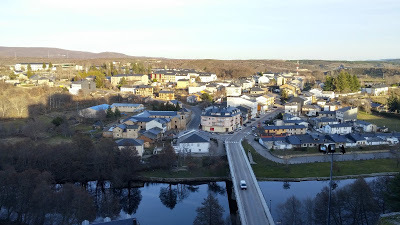 The view from the castle After the climb to the robust, legend-filled castle at the top of Puebla’s dramatic rocky outcrop, we stood at the gusty vista point to gaze down at the river and newer part of town below. We read a plaque that advocates a tenuous connection between this place and Miguel de Cervantes, then headed west on streets lustrous with slate paving beneath balconies made of hand-carved wood.
The view from the castle After the climb to the robust, legend-filled castle at the top of Puebla’s dramatic rocky outcrop, we stood at the gusty vista point to gaze down at the river and newer part of town below. We read a plaque that advocates a tenuous connection between this place and Miguel de Cervantes, then headed west on streets lustrous with slate paving beneath balconies made of hand-carved wood.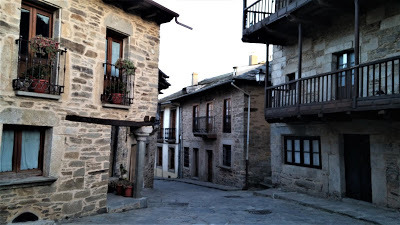
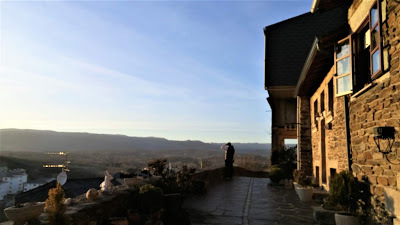 It wasn’t long before we arrived at the other side of the rock, a parapet facing a green valley and the setting sun. A line of yet more historical homes cozied up to the bottom of the rock, but one caught our attention because the roof, near our eye level, was a timber grid, and stacks of slate tiles awaited placement.
It wasn’t long before we arrived at the other side of the rock, a parapet facing a green valley and the setting sun. A line of yet more historical homes cozied up to the bottom of the rock, but one caught our attention because the roof, near our eye level, was a timber grid, and stacks of slate tiles awaited placement.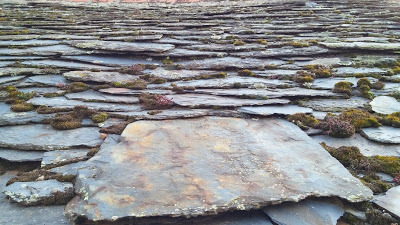 Slate roof “They’re really doing that up right,” said Daniel. “It’ll fit in with the other houses, and it’ll last forever.”
Slate roof “They’re really doing that up right,” said Daniel. “It’ll fit in with the other houses, and it’ll last forever.”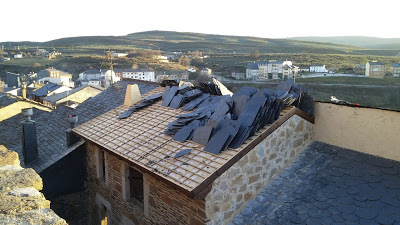 New "old" construction. A cat darted across the parapet, shooed by a woman in house slippers and a T-shirt farther down the street. “Sorry,” she said as we approached. “The cats get into my plants!”
New "old" construction. A cat darted across the parapet, shooed by a woman in house slippers and a T-shirt farther down the street. “Sorry,” she said as we approached. “The cats get into my plants!”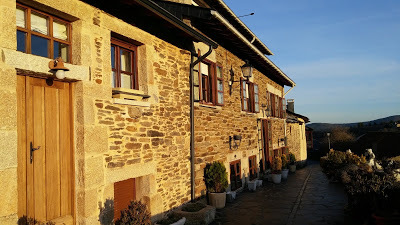 Pots and vases covered the parapet in front of her house, which she said they’d built in the 80s with high hopes. “It’s really big,” she said. “It’s only this wide, but goes way back, and it has two stories and the attic, which we were allowed to build because the house that was here before had one.”
Pots and vases covered the parapet in front of her house, which she said they’d built in the 80s with high hopes. “It’s really big,” she said. “It’s only this wide, but goes way back, and it has two stories and the attic, which we were allowed to build because the house that was here before had one.”“This was only built in the 80s? It looks much more historical,” said Daniel.
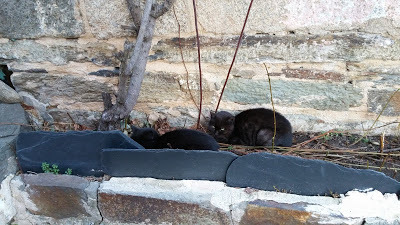 “The city makes us use traditional materials. See, the window frames are wooden. The sun batters the façade in the summer—it gets to be 40 degrees Celsius right here.” I believed her. At sunset in February, my jacket already felt heavy. “And in the winter, the frost comes and splits the wood, no matter how hard it is.”
“The city makes us use traditional materials. See, the window frames are wooden. The sun batters the façade in the summer—it gets to be 40 degrees Celsius right here.” I believed her. At sunset in February, my jacket already felt heavy. “And in the winter, the frost comes and splits the wood, no matter how hard it is.”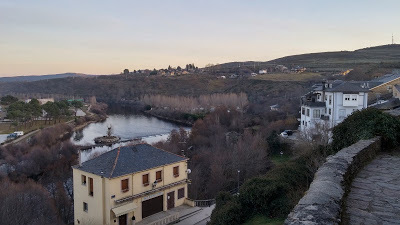 “They make PVC that looks a lot like wood now,” said Daniel.
“They make PVC that looks a lot like wood now,” said Daniel.“I wish I could use PVC, but the city won’t let me. It has to be authentic for the tourists.”
Black mascara that must’ve once matched her hair color ran down her cheeks in the tracks of old tears. Her husband had passed away five years before. The children had all moved away, one as far as Valencia. They encouraged their mother to convert the grand family inheritance into a hotel, like many of the other homes in the old town. Otherwise, it was headed for neglect and ruin, with no one there to care for it. It looked as if the woman wanted to tell us she would live forever to personally take care of this legacy.
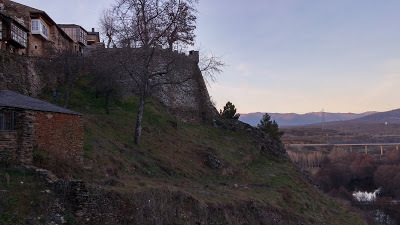 When we said our goodbyes and moved on, I spied the shadow of someone waiting for the woman at the end of the hall. A sister or cousin, as bent by time as she, hadn’t made it into her loneliness narrative. But I was relieved she had some company in her battle against the two fronts of history and progress. Puebla de Sanabria is touched by time, after all.
When we said our goodbyes and moved on, I spied the shadow of someone waiting for the woman at the end of the hall. A sister or cousin, as bent by time as she, hadn’t made it into her loneliness narrative. But I was relieved she had some company in her battle against the two fronts of history and progress. Puebla de Sanabria is touched by time, after all.
Published on May 09, 2019 02:36
April 29, 2019
Visigoths in Palencia! San Juan de Baños
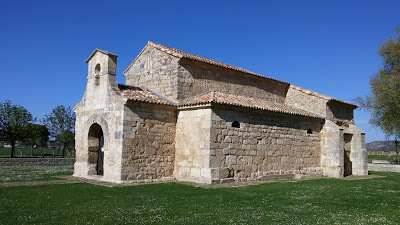 San Juan de Baños
San Juan de BañosAll photos in this post 2019 Jessica Knauss It might cheapen the effect to give you the money shot of this lovely historical building right at the top of the post. In reality, it's not something a casual traveler stumbles upon. Like most Visigothic monuments, San Juan de Baños is in a tiny locality not known for any other reason. I had to randomly hear about this, the only Visigothic church with a firm date, figure out where the heck Baños de Cerrato is, and then wait until I found a friend as crazy as I am about historical-themed road trips to take me there. Overall, there is a high risk of spending your time in the unique, fascinating small city of Palencia, never knowing what you missed.
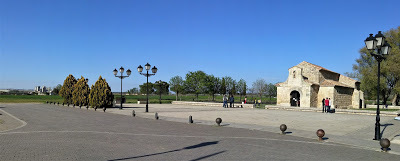 San Juan de Baños has the feeling of being nowhere,
San Juan de Baños has the feeling of being nowhere, but it's right next to an industrial area. This church is in this location for a specific reason. In January 661, King Reccesvinthus was returning to Toledo from fighting rebellious Basque tribes in the north and feeling rather poorly, as you well might in the early Middle Ages. The cortege stopped in Balneos (now Baños de Cerrato) because someone had heard of the curative waters there. It had been a spa town since Roman times. Reccesvinthus drank the water and felt much better. This miracle inspired him to found a water/baptism-themed church in that very spot.
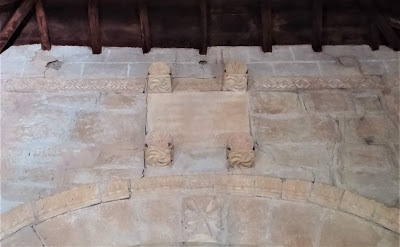 The original dedication stone is up high and decorated with sunbursts. The church still proudly displays the stone on which Reccesvinthus inscribed his dedication of the church:
The original dedication stone is up high and decorated with sunbursts. The church still proudly displays the stone on which Reccesvinthus inscribed his dedication of the church: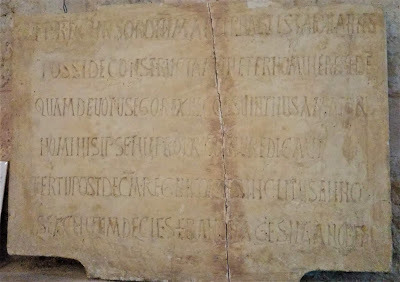 A replica of the dedication stone is set where visitors can read it. "The precursor of the Lord, the martyr Saint John the Baptist, owns this house, built as an eternal gift that I, King Reccesvinthus, devout worshiper of your name, dedicated to you, by my own right, in the third year after the tenth as illustrious companion of this kingdom. In the year 661."
A replica of the dedication stone is set where visitors can read it. "The precursor of the Lord, the martyr Saint John the Baptist, owns this house, built as an eternal gift that I, King Reccesvinthus, devout worshiper of your name, dedicated to you, by my own right, in the third year after the tenth as illustrious companion of this kingdom. In the year 661."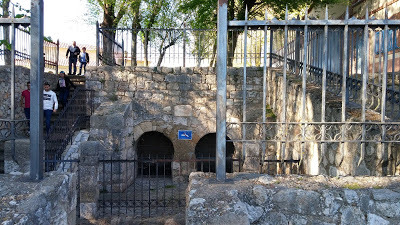 Water quality is not guaranteed. That didn't stop my friend! The fountain has fallen into disrepair and been rebuilt many times since Reccesvinthus's time, but the spring water has never stopped flowing. The latest reconstruction is from the 1940s, with two horseshoe arches that echo the architecture of the church.
Water quality is not guaranteed. That didn't stop my friend! The fountain has fallen into disrepair and been rebuilt many times since Reccesvinthus's time, but the spring water has never stopped flowing. The latest reconstruction is from the 1940s, with two horseshoe arches that echo the architecture of the church.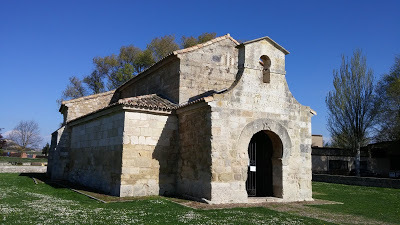 Most of the stones here and especially the horseshoe arch
Most of the stones here and especially the horseshoe arch were put together in 661! The building itself is in a remarkable state of conservation. The bell gable was added in 1865. Apart from that, the only extant features that are not from 661 are the roof, the jalousies (lacy stone window panes that must be modeled on pre-Romanesque buildings I adore in Oviedo), and the floor.
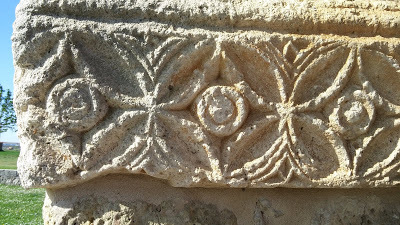 The geometric floral friezes in the door will be echoed inside.
The geometric floral friezes in the door will be echoed inside. 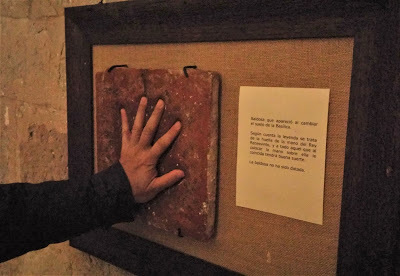 Archaeologists took advantage of the rehabilitation of the floor to dig around and find many wonderful items that are now housed in the Museum of Palencia, such as Visigothic burials and a curious tile. It showed up in the excavations with an imperious hand print, giving rise to the legend that it was Reccesvinthus's way of signing the church he ordered to be built. Whosoever possesseth a hand that fitteth into the impression exactly shall be named new King of the Visigoths. As you can see, my friend is now King Daniel of the Visigoths. I tried too, but my pinkie was too short. The page pictured next to the replica says only that a perfect fit will give the hand's owner good luck. I guess they're not ready to hand the crown over, even though the kingdom no longer exists!
Archaeologists took advantage of the rehabilitation of the floor to dig around and find many wonderful items that are now housed in the Museum of Palencia, such as Visigothic burials and a curious tile. It showed up in the excavations with an imperious hand print, giving rise to the legend that it was Reccesvinthus's way of signing the church he ordered to be built. Whosoever possesseth a hand that fitteth into the impression exactly shall be named new King of the Visigoths. As you can see, my friend is now King Daniel of the Visigoths. I tried too, but my pinkie was too short. The page pictured next to the replica says only that a perfect fit will give the hand's owner good luck. I guess they're not ready to hand the crown over, even though the kingdom no longer exists!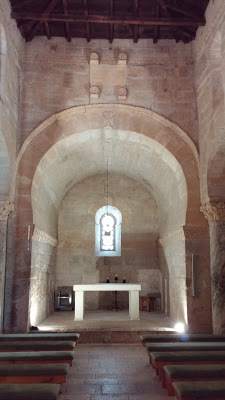 The main altar. The wooden roof is made to
The main altar. The wooden roof is made to look as it might have in Visigothic times. When you enter, the space is not large, but the simple lines of construction produce a sense of vastness. Horseshoe arches dominate the scene, proving that the Iberian Peninsula did not have to wait until the Arabs and Berbers took over in order to grace its buildings with this pleasing shape. We see them in the grand arch of the main altar, the windows, and between eight columns.
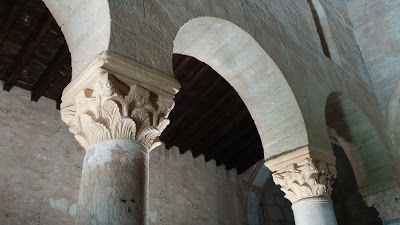 The guide says the lateral arches are slightly irregular, but you would really have to look to spot the flaws. The impression is of stately harmony.
The guide says the lateral arches are slightly irregular, but you would really have to look to spot the flaws. The impression is of stately harmony.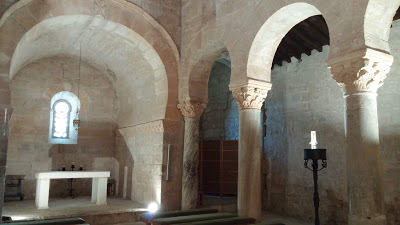 The marble columns have been harvested from Roman villas that have long since disappeared. Most if not all the stones used in the rest of the church are also likely recycled from Roman buildings. In this way, the Roman legacy has come down to us today, only slightly altered.
The marble columns have been harvested from Roman villas that have long since disappeared. Most if not all the stones used in the rest of the church are also likely recycled from Roman buildings. In this way, the Roman legacy has come down to us today, only slightly altered.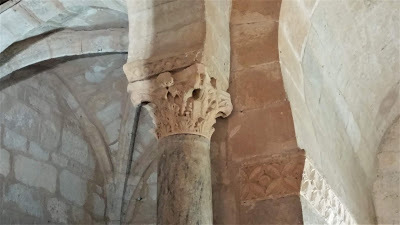 The recycled Roman capital is right next to the main altar. One Corinthian column capital has been identified as a late Roman carving based solely on its style.
The recycled Roman capital is right next to the main altar. One Corinthian column capital has been identified as a late Roman carving based solely on its style.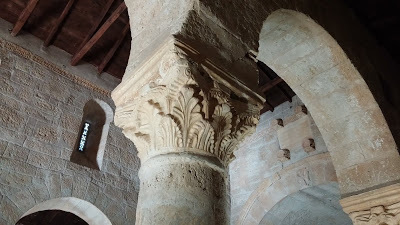 The other capitals are also Corinthian style, but the execution is less ornate. The guide seemed to think the Visigothic artisans were unable to produce the same level of detail as their direct Roman forebears. Having studied the purposeful simplicity of Romanesque art as contrasted with the complexities of the Gothic area, I appreciate the clean lines of the Visigothic capitals and believe the differences between them and the Roman one are due to taste.
The other capitals are also Corinthian style, but the execution is less ornate. The guide seemed to think the Visigothic artisans were unable to produce the same level of detail as their direct Roman forebears. Having studied the purposeful simplicity of Romanesque art as contrasted with the complexities of the Gothic area, I appreciate the clean lines of the Visigothic capitals and believe the differences between them and the Roman one are due to taste.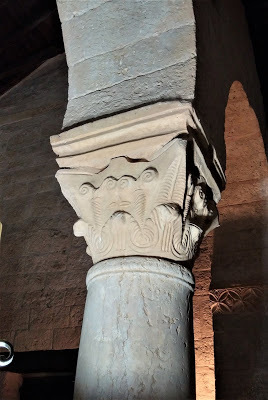 I especially like this capital because the interpretation of the Corinthian pattern is so free, and because the diminutive four-petaled flower in the center inserts the new Christian symbolism into an ancient context.
I especially like this capital because the interpretation of the Corinthian pattern is so free, and because the diminutive four-petaled flower in the center inserts the new Christian symbolism into an ancient context.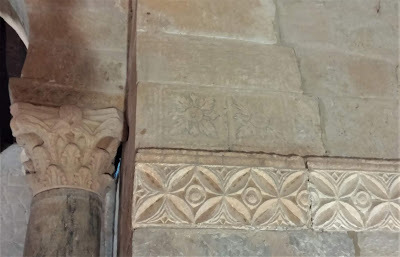 Lest we think the ancient and medieval world was all bare stone, the guide was careful to point out the paint traces. Medieval people did not want to look at their construction materials in their finished edifices any more than we would want to stare at rebar or insulation. They filled their buildings with color and shapes! Here you can also appreciate the geometric flower friezes, repeated throughout the building, inside and out. Interest, focal points, horror vacui, it's all here, in this seemingly simple space.
Lest we think the ancient and medieval world was all bare stone, the guide was careful to point out the paint traces. Medieval people did not want to look at their construction materials in their finished edifices any more than we would want to stare at rebar or insulation. They filled their buildings with color and shapes! Here you can also appreciate the geometric flower friezes, repeated throughout the building, inside and out. Interest, focal points, horror vacui, it's all here, in this seemingly simple space.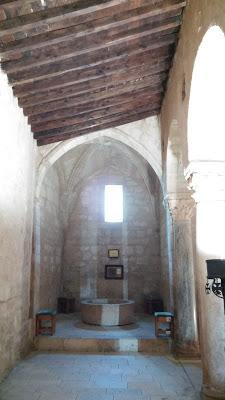 In keeping with the baptism theme, San Juan de Baños boasts an ancient baptismal font, exactly the kind of thing I imagine Mudarra using in Seven Noble Knights. The lack of decoration makes it hard to date, but the guide said the best guess places it between the fifth and sixth centuries. Adults would have stripped down and stepped right in to be initiated into the Christian church.
In keeping with the baptism theme, San Juan de Baños boasts an ancient baptismal font, exactly the kind of thing I imagine Mudarra using in Seven Noble Knights. The lack of decoration makes it hard to date, but the guide said the best guess places it between the fifth and sixth centuries. Adults would have stripped down and stepped right in to be initiated into the Christian church.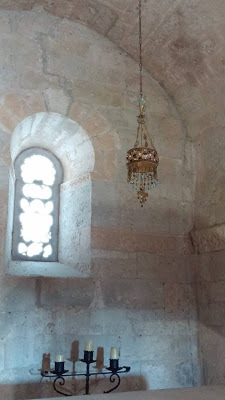 A replica of Reccesvinthus's votive crown is hanging in the space it was probably meant for. I've seen the original at the National Archaeological Museum in Madrid and admired the fine metalwork and precious jewels. The sight of the replica in situ moved me deeply.
A replica of Reccesvinthus's votive crown is hanging in the space it was probably meant for. I've seen the original at the National Archaeological Museum in Madrid and admired the fine metalwork and precious jewels. The sight of the replica in situ moved me deeply.San Juan de Baños is consecrated, but is only used for visits like this and for weddings. It would be an exceptionally elegant place to say vows, in my humble opinion.
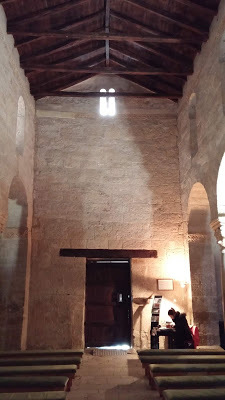 The foot of the church with the door
The foot of the church with the door and the guide's station.
Palencia is the host of one more of these rare pieces of Visigothic architecture, and it has another legend attached to its founding, so check this space for more!
Published on April 29, 2019 10:56
April 27, 2019
Zamora's Medieval Treasures: Holy Week 2019
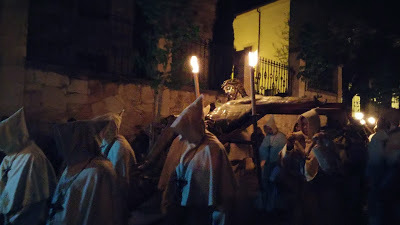 Tuesday night of Holy Week
Tuesday night of Holy WeekJessica Knauss 2019 I honestly thought that, this being my second Holy Week in Zamora, I could maintain a more distanced perspective on this apotheosis of folklore, popular religion, and art. I figured I'd pick up the processions I missed last year and the week would be mostly normal, a proper rest during which I could probably get some writing done.
How quickly we forget!
Last year, I had to skip the Friday of Sorrows procession of the Penitential Brotherhood of the Most Holy Christ of the Holy Spirit because the weather was terrible. Being the first late-night procession, I didn't know what I was missing and so didn't have the wherewithal to trek across Zamora in the nighttime wind and rain. This year, I arrived early enough to catch the perfect spot at the iron fence around the cathedral atrium, early enough to watch several TV crews setting up. And still I thought it would be no big deal.
The cathedral plaza filled with enthusiasts, and the air became thick with expectancy. The choir assembled in the atrium, and one of the choristers even came out to the fence where I was to chat with his girlfriend. And then the first brotherhood members appeared in their white monklike hoods with the first "float" an intensely heavy bell that rang loud enough to imbue everything with medieval-tinged magic.
Holy Week magic was back!
I couldn't miss anything from then on. I saw every procession I missed last year and tried to revisit old favorites to a memorable, soggy conclusion. I saw colors, smelled incense, and above all, heard amazing music.
I'd booked a trip to Palencia when I was still thinking I would be more blasé about Zamoran Holy Week, and managed to catch a procession there, too. Amazing to compare to two cities' Holy Saurday traditions.
The trip to Palencia was well worth it, and you will see some gems from that medieval province on this blog.
I've now seen every single one of the processions already (some of them twice), so trust me, there's no way I'll lose my head over the magic of Holy Week again. (Hmmm...)
To round out your experience of Holy Week in Zamora, visit last year's post and last year's anticipatory post.
Published on April 27, 2019 09:50
April 2, 2019
Romanesque with a Twist: Almazán, Soria
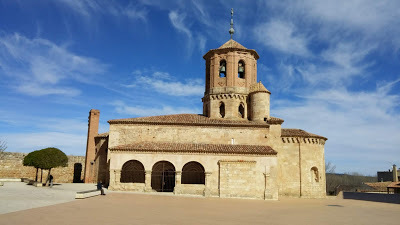 Twelfth-century San Miguel in Almazán
Twelfth-century San Miguel in AlmazánAll photos in this post 2019 Jessica Knauss I'd been too satisfied with our visit to Almenar to think about much else, but Daniel said, "We have to visit Almazán. Trust me." He was using a guidebook to the "best" Romanesque sites in Spain, and it was turning out to be highly reliable, and really, I'm content with any vaguely medieval site you can show me, so of course I didn't object.
What are some good adjectives for Almazán? Twisted. Skewed. Awry. Catawumpus. Cockeyed.
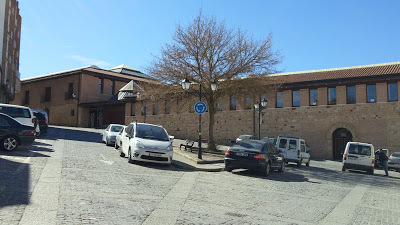 How so? The above photo is the plaza where we parked. Notice anything unusual?
How so? The above photo is the plaza where we parked. Notice anything unusual?But let's allow the Romanesque Church of San Miguel to fully illustrate this idea.
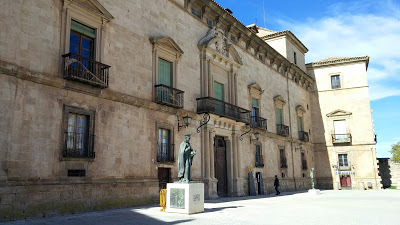 San Miguel is in the enormous Plaza Mayor, where the Palace of the Counts of Altamira serves as the tourism office. There you buy your ticket for the church tour. We had many other wonders on our itinerary that day, so we hesitated. I'm so glad we stayed.
San Miguel is in the enormous Plaza Mayor, where the Palace of the Counts of Altamira serves as the tourism office. There you buy your ticket for the church tour. We had many other wonders on our itinerary that day, so we hesitated. I'm so glad we stayed.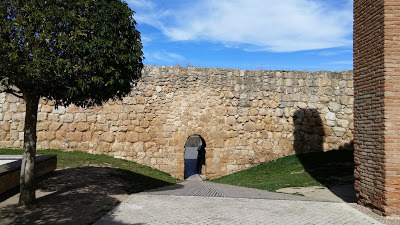 San Miguel is right up against the medieval town wall. This National Monument was started in the twelfth century. It's fundamentally a Cistercian structure, but the external decoration of the apse has Lombardic-Catalan influence. The lantern is octagonal, using the Romanesque number symbolism for resurrection and suggesting that this church was important in burial rites. Its brickwork screams Mudejar style, and when we go inside, we see that style persists in the dome underneath it. The stones and bricks are laid with the exacting care typical of Romanesque perfectionism.
San Miguel is right up against the medieval town wall. This National Monument was started in the twelfth century. It's fundamentally a Cistercian structure, but the external decoration of the apse has Lombardic-Catalan influence. The lantern is octagonal, using the Romanesque number symbolism for resurrection and suggesting that this church was important in burial rites. Its brickwork screams Mudejar style, and when we go inside, we see that style persists in the dome underneath it. The stones and bricks are laid with the exacting care typical of Romanesque perfectionism.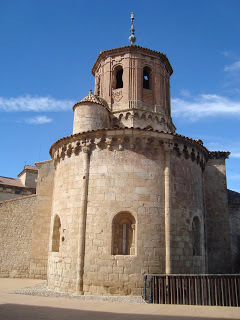 So when Daniel said we had to see this church because its floor plan is uniquely crooked--couldn't I see it?--I was gobsmacked. No, I couldn't see it, no matter how many photos I snapped. Examining them now, I notice the evidence. Above, for example, the semicircular apse doesn't have a 90-degree angle on either side where it meets the transept. You can kind of see how it doesn't line up with the lantern tower.
So when Daniel said we had to see this church because its floor plan is uniquely crooked--couldn't I see it?--I was gobsmacked. No, I couldn't see it, no matter how many photos I snapped. Examining them now, I notice the evidence. Above, for example, the semicircular apse doesn't have a 90-degree angle on either side where it meets the transept. You can kind of see how it doesn't line up with the lantern tower.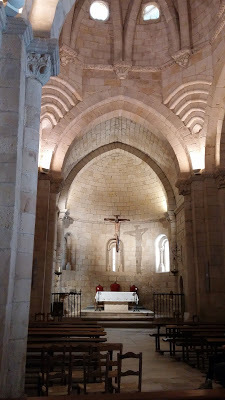 More clues are found in this close-up of the apse from the inside. Notice how the pew benches line up with the transept and end up at a wonky angle from the main altar. The crucifix hangs exactly between the sides of the archway, but fails to hang directly in front of the central window. The outermost and inner arches themselves (lightly pointed in Cistercian style) are off kilter.
More clues are found in this close-up of the apse from the inside. Notice how the pew benches line up with the transept and end up at a wonky angle from the main altar. The crucifix hangs exactly between the sides of the archway, but fails to hang directly in front of the central window. The outermost and inner arches themselves (lightly pointed in Cistercian style) are off kilter.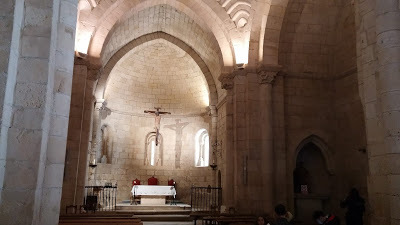 It's even easier to see in this horizontal photo, considering that I'm standing square with the transept--insofar as that's possible.
It's even easier to see in this horizontal photo, considering that I'm standing square with the transept--insofar as that's possible. 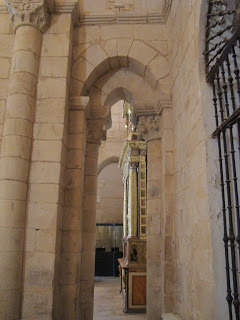 This archway on the left of the apse, close to number 8 on the floor plan below, ended up ridiculously compressed while its mate on the right gives a good pretense of being normal.
This archway on the left of the apse, close to number 8 on the floor plan below, ended up ridiculously compressed while its mate on the right gives a good pretense of being normal.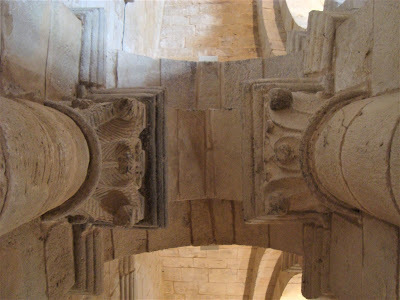 In this shot of the same arch seen from below, I dare you to find something--anything!--that lines up properly.
In this shot of the same arch seen from below, I dare you to find something--anything!--that lines up properly.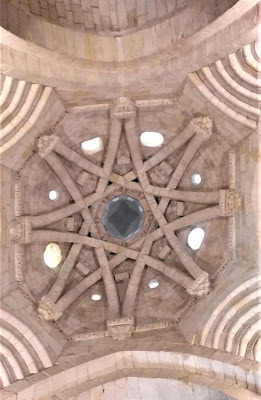 The tour guide rightly spent a lot of time pointing out the features of the magnificent dome. Eight slim arches cross to form an octagonal opening at the top. This is already a great architectural feat, but because we're in Almazán, it has the uniqueness of making the stone look like taffy that's been given a good pull.
The tour guide rightly spent a lot of time pointing out the features of the magnificent dome. Eight slim arches cross to form an octagonal opening at the top. This is already a great architectural feat, but because we're in Almazán, it has the uniqueness of making the stone look like taffy that's been given a good pull.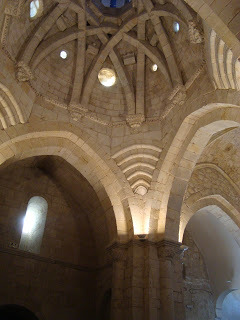 I stared up at the dome, but got overwhelmed... by its immense beauty.
I stared up at the dome, but got overwhelmed... by its immense beauty.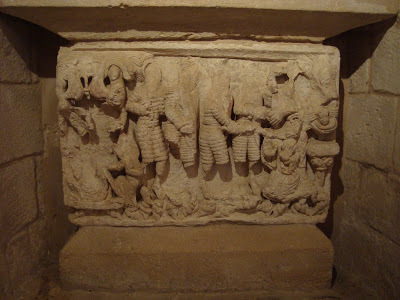 We weren't allowed to take photos of any of the very fine painted Gothic and Baroque figures in the church, but luckily, this altar frontal is in bare stone. Although badly worn away or perhaps mutilated, the carving that remains is exquisite. It's a depiction of the martyrdom of Thomas à Becket. This English saint was killed (by a large number of knights, in this depiction) in front of the altar inside Canterbury Cathedral in 1170.
We weren't allowed to take photos of any of the very fine painted Gothic and Baroque figures in the church, but luckily, this altar frontal is in bare stone. Although badly worn away or perhaps mutilated, the carving that remains is exquisite. It's a depiction of the martyrdom of Thomas à Becket. This English saint was killed (by a large number of knights, in this depiction) in front of the altar inside Canterbury Cathedral in 1170.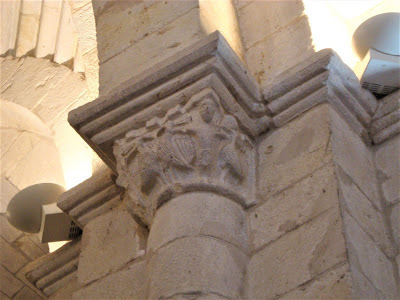 Most of the column capitals are Cistercian plant patterns, but a few were lovely, if high-up, allegories of uncertain interpretation. Here, for example, we have a man on the corner gripping birds by the neck. Birds usually represent the human soul, but it's hard to tell whether they're being saved or dragged down in this case. If anyone has seen this capital closer up and knows of a detail that reveals its intention, please let me know!
Most of the column capitals are Cistercian plant patterns, but a few were lovely, if high-up, allegories of uncertain interpretation. Here, for example, we have a man on the corner gripping birds by the neck. Birds usually represent the human soul, but it's hard to tell whether they're being saved or dragged down in this case. If anyone has seen this capital closer up and knows of a detail that reveals its intention, please let me know!Almazán's quirkiness is probably best illustrated by the floor plan:
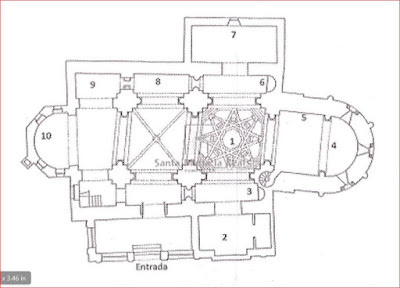 Floor plan from the pamphlet,
Floor plan from the pamphlet, produced by the Most Excellent City Government of AlmazánA lady on the tour had been sitting in one of the pews. When she stood up, she said it made her dizzy! I was trying not to walk or turn around too fast, myself, but I got overexcited, anyway (as I'm prone to do in such places), and felt the seasickness effect for a second. It made me wonder, as everyone else on the tour already had, why the church had been purposefully constructed in such an unusual manner. Did they want to make themselves dizzy with devotion?
The tour guide insisted we'll never know the answer. One idea is that a few Romanesque churches took the symbolism of their floor plans a long way: figuring that the transept represents the arms of Jesus's cross, the apse must represent the head. The apse is, indeed, considered the holiest part of any Western Catholic medieval church. Since Jesus's head is tilted in most crucifixions, some ingenious architects tilted their apses. But this cannot be the case here, because Jesus's head always tilts toward his right, and if you consider the floor plan, this apse tilts toward his left. Additionally, the apse tilt is only the most obvious part of the twisting nature of this church.
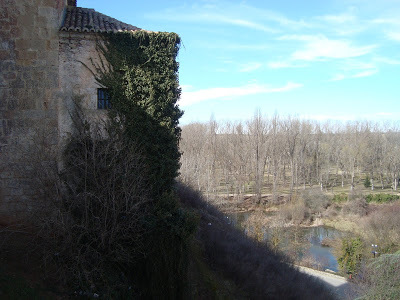 This ivy-covered building is the Santa Teresa Chapel, which makes up the left side of the transept, number 7 in the floor plan above. Here we see the drop-off that starts right at the edge of church and the town wall. The church was a major component in the city's fortification. Perhaps the builders needed to follow the line of the cliff so the defense wouldn't be interrupted with weak points where enemies could gain their footing. Of course, that begs the question, again, why would they want to follow the landscape so literally with the entire building? Why not make only one side curvy? Why not continue the wall along the cliff and bring the church in a little way so it could be a regular, straight, tidy Cistercian Romanesque beacon?
This ivy-covered building is the Santa Teresa Chapel, which makes up the left side of the transept, number 7 in the floor plan above. Here we see the drop-off that starts right at the edge of church and the town wall. The church was a major component in the city's fortification. Perhaps the builders needed to follow the line of the cliff so the defense wouldn't be interrupted with weak points where enemies could gain their footing. Of course, that begs the question, again, why would they want to follow the landscape so literally with the entire building? Why not make only one side curvy? Why not continue the wall along the cliff and bring the church in a little way so it could be a regular, straight, tidy Cistercian Romanesque beacon? I fancy someone wrote down the extensive debates that took place over this issue in the public forum, and one day, someone will find that record. In the meantime, it could be a fun plot point in a historical novel...
Published on April 02, 2019 10:09
March 30, 2019
Fertile Fields, Fields of Blood: Medieval Soria
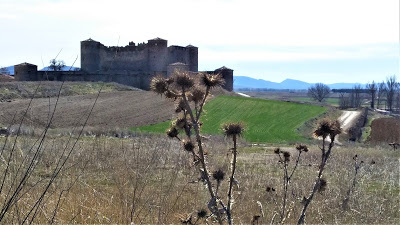 Almenar de Soria
Almenar de SoriaAll photos in this post 2019 Jessica Knauss unless otherwise credited.
* * * Young Gonzalo sat astride his mount on the valley crest with his brothers, his tutor, his uncle, and both companies of troops behind him. The valley of Almenar opened out green beneath them, fragrant as the morning sunlight warmed the dewy grasses. A hundred head of cattle grazed lazily, surrounded by droves of bleating sheep, their shepherd perhaps resting, hidden among the brush. Young Gonzalo heard the animals' calls beckoning him.
"It's everything our uncle promised." A jackrabbit bounded between his horse's legs.
* * *
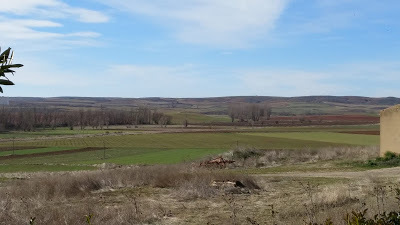 The fields at Almenar Part One, Chapter VIIII of Seven Noble Knights is one of the most challenging passages I've ever written. Not only did I have to research plausible details for the the biggest and most pivotal battle in the book, but I had to put the reader in the valley, fighting alongside Gonzalo and his brothers. I needed the reader to feel the emotional equivalent of the sweat and blood the seven noble knights had to wade through. If this chapter wasn't convincing and memorable, the rest of the epic story would be hardly worth reading.
The fields at Almenar Part One, Chapter VIIII of Seven Noble Knights is one of the most challenging passages I've ever written. Not only did I have to research plausible details for the the biggest and most pivotal battle in the book, but I had to put the reader in the valley, fighting alongside Gonzalo and his brothers. I needed the reader to feel the emotional equivalent of the sweat and blood the seven noble knights had to wade through. If this chapter wasn't convincing and memorable, the rest of the epic story would be hardly worth reading.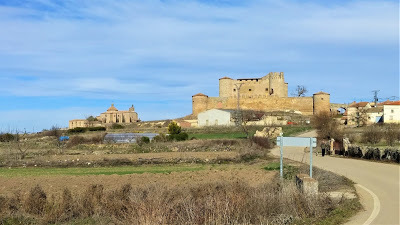 And I had to accomplish all this with no knowledge of the location. All I had to go on was Google Maps and the features the medieval source texts required of the terrain.
And I had to accomplish all this with no knowledge of the location. All I had to go on was Google Maps and the features the medieval source texts required of the terrain.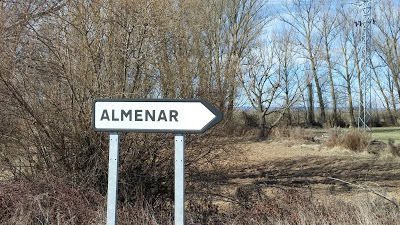 This way to Almenar! It's mind-blowing
This way to Almenar! It's mind-blowing to see place names in real life when you've imagined them so passionately. As the result of an extraordinary force of will, I now live in Spain! I'm also fortunate to have found a wonderful traveling companion in my friend, Daniel, who likes visiting out-of-the-way medieval treasures almost as much as I do. I said, "Soria is the only province in Castilla y León I haven't really seen," and he planned a trip there at the beginning of March that was nearly as epic as Seven Noble Knights.
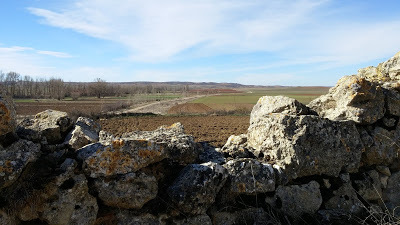 There are few things that make me feel more thankful than driving around in the Spanish countryside. As we left the province of Burgos, home to Salas de los Infantes, I imagined marching with my characters toward the fertile fields of Soria to take cattle and whatever loot they could find. I'm happy to report that Soria today matches the description in the excerpt above. It's resplendent with rolling farmlands and wild areas with much more possibility for cultivation than the rocky (though still beautiful to me) soil of Zamora.
There are few things that make me feel more thankful than driving around in the Spanish countryside. As we left the province of Burgos, home to Salas de los Infantes, I imagined marching with my characters toward the fertile fields of Soria to take cattle and whatever loot they could find. I'm happy to report that Soria today matches the description in the excerpt above. It's resplendent with rolling farmlands and wild areas with much more possibility for cultivation than the rocky (though still beautiful to me) soil of Zamora.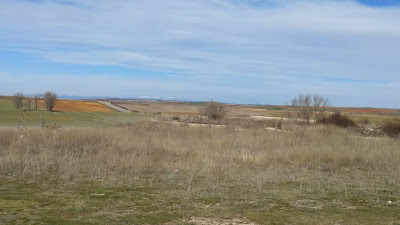 When we came up on Almenar, the site of the battle, the valley opened out below us even bigger than I'd imagined. Over one thousand years, the undulations of the land have surely changed, so I'm not too bothered that I couldn't grasp exactly where every important moment would've taken place.
When we came up on Almenar, the site of the battle, the valley opened out below us even bigger than I'd imagined. Over one thousand years, the undulations of the land have surely changed, so I'm not too bothered that I couldn't grasp exactly where every important moment would've taken place.* * * The opposite crest was swimming in the red, blue, white, black, yellow, and green banners of Moorish soldiers as they appeared to rise out of the ground, sending the cattle lowing in every direction. The fluttering obscured the men beneath the flags and made it difficult to estimate their number, but if their hill was as wide as the one from which he now looked, there could be as many as three hundred.
* * *
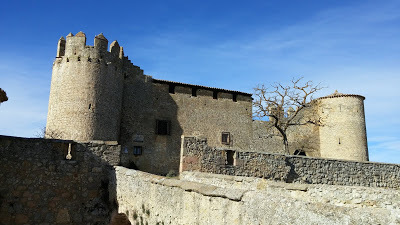 Almenar Castle with the bridge over its moat, which is behind a locked gate The biggest surprise was the existence of the castle. It shouldn't have been a surprise, since "Almenar" refers to a battlement or watchtower, but there it was, with its own history. I regret that we couldn't find anyone to open the castle up to us, because from there, the views of the valley would have been the most impressive.
Almenar Castle with the bridge over its moat, which is behind a locked gate The biggest surprise was the existence of the castle. It shouldn't have been a surprise, since "Almenar" refers to a battlement or watchtower, but there it was, with its own history. I regret that we couldn't find anyone to open the castle up to us, because from there, the views of the valley would have been the most impressive.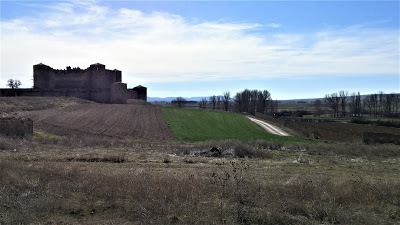 Some sources say the oldest parts of the castle are contemporary with my characters, the tenth century. This would be parts of the homage tower or keep, which we couldn't get close enough to inspect. If there was a castle in the tenth century, then the seven noble knights would've seen the Moorish troops coming at them from around it.
Some sources say the oldest parts of the castle are contemporary with my characters, the tenth century. This would be parts of the homage tower or keep, which we couldn't get close enough to inspect. If there was a castle in the tenth century, then the seven noble knights would've seen the Moorish troops coming at them from around it.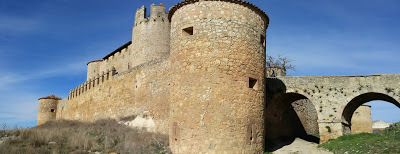 Most of the castle as seen today was built in the fifteenth and sixteenth centuries and belonged to the Counts of Gómara. Carlos II and Felipe V were in residence at certain times. This castle also inspired some of the legends written by the famous Romantic poet, Gustavo Adolfo Bécquer, and it's said he lived and wrote there. (It looks like a pretty good writers' retreat to me.) There was a sign on the door we could barely make out that said something about the modernist poet Antonio Machado and his young wife, Leonor Izquierdo, staying there, as well, and I later read that Leonor was born in Almenar.
Most of the castle as seen today was built in the fifteenth and sixteenth centuries and belonged to the Counts of Gómara. Carlos II and Felipe V were in residence at certain times. This castle also inspired some of the legends written by the famous Romantic poet, Gustavo Adolfo Bécquer, and it's said he lived and wrote there. (It looks like a pretty good writers' retreat to me.) There was a sign on the door we could barely make out that said something about the modernist poet Antonio Machado and his young wife, Leonor Izquierdo, staying there, as well, and I later read that Leonor was born in Almenar.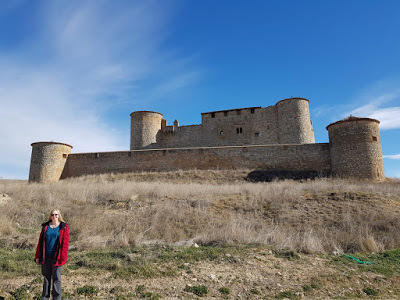 Photo 2019 Daniel Sanz The well-preserved castle is now privately owned.
Photo 2019 Daniel Sanz The well-preserved castle is now privately owned.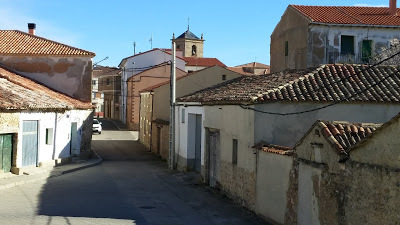 The town of Almenar comes right up to the castle.
The town of Almenar comes right up to the castle.
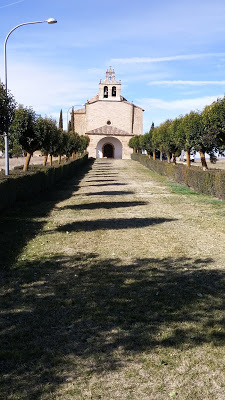 Hermitage of the Virgin of La Llana,
Hermitage of the Virgin of La Llana,eighteenth century.
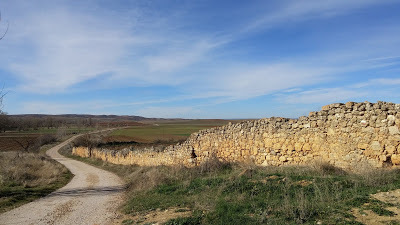
I'm glad the castle looms over the bucolic landscape today. The contrast between the peaceful fields and the manifestation of military power in stone reminds us of the battles, but also what so many were fighting for.
* * * The moment the brothers appeared once again at the entrance of the tent, the drummers gave a terrifying crash and the Moorish knights fell on them, surefooted even on the undulating slope. Gonzalo gripped his sword as his only lifeline and thrust outward, cutting and swiping at whatever he could. The Moors in charge of moving the dead and wounded took away a hundred soldiers within two hours. Gonzalo fought on two fronts: the fear rising from his darkest heart had to be beaten back at every turn, and the neverending troops had to be cut down.
. . . and still the soldiers kept coming, with fresh horses and undamaged shields. Their prey could hardly move enough to control their own hands, and most of them had broken their shields in half and lost either their swords or their close-range daggers.
* * *
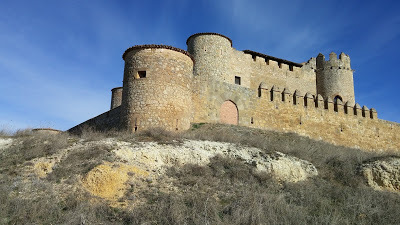 All excerpts from Part One, Chapter VIIII of Seven Noble Knights. Check this space or sign up for my newsletter to find out when this epic novel of family, betrayal, and revenge in medieval Spain becomes available again!
All excerpts from Part One, Chapter VIIII of Seven Noble Knights. Check this space or sign up for my newsletter to find out when this epic novel of family, betrayal, and revenge in medieval Spain becomes available again!More adventures in Soria are available at my Facebook page (March 2019), but I've saved the best parts for future posts here!
Published on March 30, 2019 05:14
January 27, 2019
Villalcázar de Sirga: The Miracle Worker
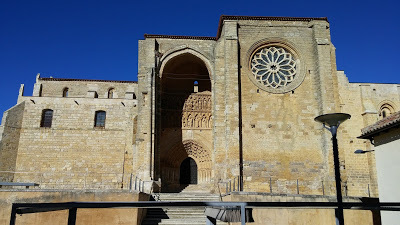 The south facade of Santa Maria la Blanca, Villalcázar de Sirga
The south facade of Santa Maria la Blanca, Villalcázar de SirgaPhotos in this post 2019 Jessica Knauss The first weekend of 2019, I stayed with a friend in Burgos. We were looking for historical excursions (not hard to find!) in the north of the province of Palencia because I've read about the Romanesque wonders there and feel like I haven't seen much of what it has to offer. The pilgrims' Road to Santiago goes through the north of Palencia, and my friend wanted to show me Carrión de los Condes, a stop along the Road with famous Romanesque churches. The map doesn't lie, and right next to that wonderful location, the place name Villalcázar de Sirga set off a million (or maybe fourteen?) bells in my head.
"There's a miracle-working Virgin there," I said. "The Cantigas mention her a lot." As shown in the previous post, there are no fewer than fourteen cantigas (3 percent!) telling only some of the miracles the Virgin Mary performed in the thirteenth century in what was then known as Villasirga.
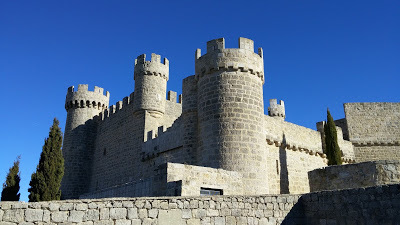 Fifteenth-century castle at Olmillos de Sasamón "We'll have to check it out after Carrión," my friend said. We planned to eat the big midday meal in Villalcázar de Sirga after a morning of other adventures. As it turned out, there was a castle in Olmillos de Sasamón we had to stop and look at, and then the churches in Carrión were so stunning that the only reason I stopped staring was that they closed for siesta. We then headed to where I knew a miraculous Virgin, a little piece of Alfonso X, el Sabio, was waiting for me.
Fifteenth-century castle at Olmillos de Sasamón "We'll have to check it out after Carrión," my friend said. We planned to eat the big midday meal in Villalcázar de Sirga after a morning of other adventures. As it turned out, there was a castle in Olmillos de Sasamón we had to stop and look at, and then the churches in Carrión were so stunning that the only reason I stopped staring was that they closed for siesta. We then headed to where I knew a miraculous Virgin, a little piece of Alfonso X, el Sabio, was waiting for me.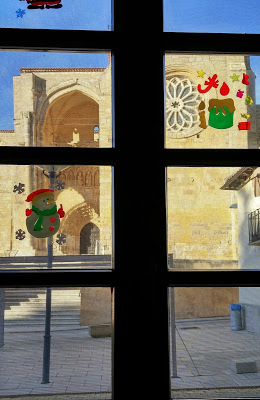 The view from the pub, with Christmas decor The town felt deserted. The plaza with the monumental Church of Santa Maria la Blanca radiated silence under a bright winter sun. We went into the charmingly named pub, La Cantigas, to find only the barkeep and owner. They told us the church only opened once a week in the winter for mass on Sundays. We were there on a Saturday. "But the website says..." we started, and they answered that someone had written whatever they felt like about the opening hours, but that church is shut tight except for mass on Sundays. And that a surprising number of people come through asking the same question and blame them for the inconvenience, sometimes with verbal violence! Hardly pilgrim-like! Of course we didn't do that, but returned to Carrión for a nice meal and to reflect on the opportunity: Now we had a chance to return more prepared.
The view from the pub, with Christmas decor The town felt deserted. The plaza with the monumental Church of Santa Maria la Blanca radiated silence under a bright winter sun. We went into the charmingly named pub, La Cantigas, to find only the barkeep and owner. They told us the church only opened once a week in the winter for mass on Sundays. We were there on a Saturday. "But the website says..." we started, and they answered that someone had written whatever they felt like about the opening hours, but that church is shut tight except for mass on Sundays. And that a surprising number of people come through asking the same question and blame them for the inconvenience, sometimes with verbal violence! Hardly pilgrim-like! Of course we didn't do that, but returned to Carrión for a nice meal and to reflect on the opportunity: Now we had a chance to return more prepared.Before the redo trip two weeks later, I read all the Villasirga cantigas and got a sense of the awesome power concentrated here. We learned that the "sirga" in the town's name refers not just to any road, but to the type of road that follows along a canal. Given that it's named for a place of transit, Villasirga has always been a site of reference for travelers. Perhaps for that reason, it is the only town to the north of the Duero River that belonged to the Order of the Knights Templar. As was their custom, they set up a hospital and hostel for weary travelers here. In the early thirteenth century, after an artist created the image of the Blessed Virgin, the town was able to compete for the massive traffic along the pilgrims' Road to Santiago. It was at that time that the Church of Santa Maria la Blanca was built, to honor this Virgin Mary and give her a grand space in which to work her miracles.
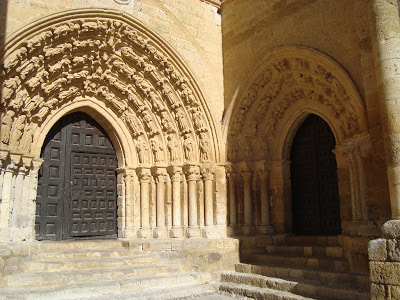 The star attraction outside is this double set of porticoed doors in the south facade, uniquely set against each other at a 90-degree angle. Although the archways are very similar in style, the leftmost door was made first as the grand entrance near the foot of the church, following Romanesque convention. The doors greet us with angels, priests, saints, and musicians. The way the figures are positioned within the arch tends toward Gothic, as is the slight point at the top. In the fourteenth century, the Chapel of Santiago was added to the transept area, and the rightmost door is a direct entry into that chapel.
The star attraction outside is this double set of porticoed doors in the south facade, uniquely set against each other at a 90-degree angle. Although the archways are very similar in style, the leftmost door was made first as the grand entrance near the foot of the church, following Romanesque convention. The doors greet us with angels, priests, saints, and musicians. The way the figures are positioned within the arch tends toward Gothic, as is the slight point at the top. In the fourteenth century, the Chapel of Santiago was added to the transept area, and the rightmost door is a direct entry into that chapel.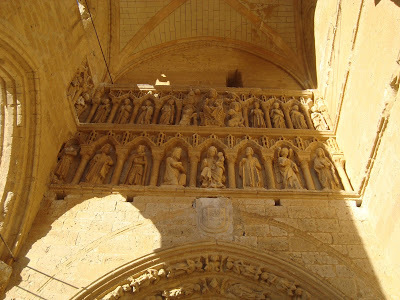 Over the leftmost archway, there's a lovely double late-Romanesque frieze. On top, we have a Christ in Majesty with the symbols of the Gospel writers ("tetramorphos," they're called) and then what were intended to be the twelve apostles spreading out on either side. On the left, two apostles extend into the next wall, while on the right, two apostles are missing. They likely existed for about a hundred years, and were removed when the new wall for the Santiago Chapel was built. Below, there's a lovely Epiphany scene, with he Virgin and Child in the center and the Magi to the left. To the right, Joseph stands in the first archway, and the final two contain the angel Gabriel making the Annunciation, and the Virgin Mary receiving the news with an appropriate degree of surprise mixed with surrender implied in her hand gesture.
Over the leftmost archway, there's a lovely double late-Romanesque frieze. On top, we have a Christ in Majesty with the symbols of the Gospel writers ("tetramorphos," they're called) and then what were intended to be the twelve apostles spreading out on either side. On the left, two apostles extend into the next wall, while on the right, two apostles are missing. They likely existed for about a hundred years, and were removed when the new wall for the Santiago Chapel was built. Below, there's a lovely Epiphany scene, with he Virgin and Child in the center and the Magi to the left. To the right, Joseph stands in the first archway, and the final two contain the angel Gabriel making the Annunciation, and the Virgin Mary receiving the news with an appropriate degree of surprise mixed with surrender implied in her hand gesture.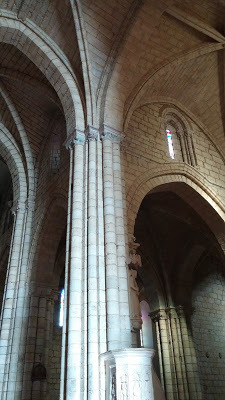 Note the painted column capitals! As I've hinted above, the construction is Romanesque-Gothic transition, so although it's built like a fortified structure with few windows, it's also voluminous. When you walk in, the whole space is illuminated through the rose window in the Santiago Chapel, and you can't help but look up at the pointed arches undulating through the upper space.
Note the painted column capitals! As I've hinted above, the construction is Romanesque-Gothic transition, so although it's built like a fortified structure with few windows, it's also voluminous. When you walk in, the whole space is illuminated through the rose window in the Santiago Chapel, and you can't help but look up at the pointed arches undulating through the upper space. 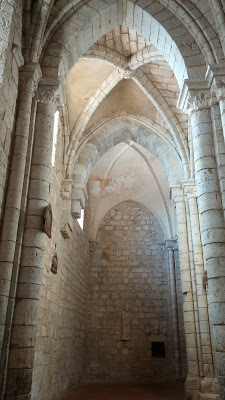
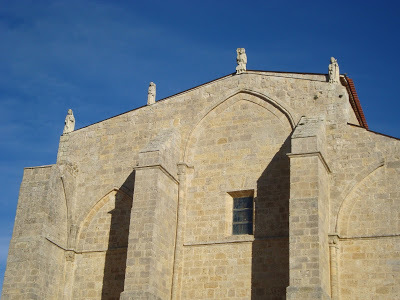 Coming back outside for a moment, the strangely plain western facade has a story that needs to be told. When it was first built, it had a magnificent Romanesque-Gothic transition doorway known as the Puerta del Ángel. It probably had hundreds of sculptures on it. We don't get to enjoy that door today because it fell as a result of the Lisbon earthquake of 1755. The current facade was built in 1888. The white statues on top were taken from the rubble of the Puerta del Ángel.
Coming back outside for a moment, the strangely plain western facade has a story that needs to be told. When it was first built, it had a magnificent Romanesque-Gothic transition doorway known as the Puerta del Ángel. It probably had hundreds of sculptures on it. We don't get to enjoy that door today because it fell as a result of the Lisbon earthquake of 1755. The current facade was built in 1888. The white statues on top were taken from the rubble of the Puerta del Ángel.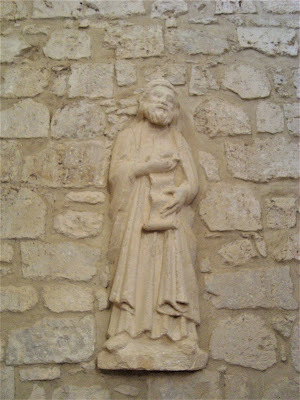 Figures and heads from the fallen door are indeed found within the church...
Figures and heads from the fallen door are indeed found within the church...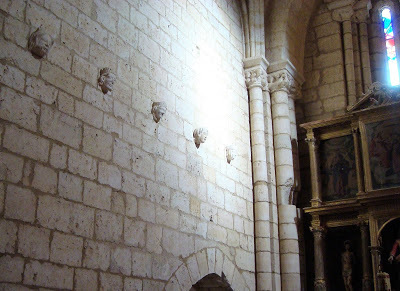
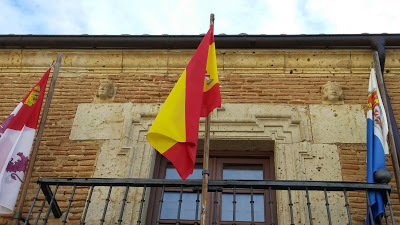 ... and in other buildings. These thirteenth-century kingly faces are set into the facade of the nineteenth-century town hall.
... and in other buildings. These thirteenth-century kingly faces are set into the facade of the nineteenth-century town hall.Knowledge of these construction events and interventions is necessary to understand the unexpected question I had to deal with on this auspicious day:
Which Virgin?
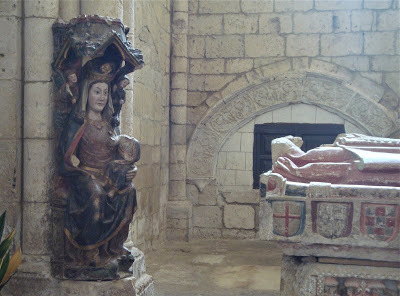 My objective in going to Villalcázar de Sirga was, of course, to see the image of the Virgin Mary that figures so prominently in the Cantigas de Santa Maria. But it wasn't as simple as walking into the church and meeting this artifact that was once in the presence of Alfonso X, el Sabio, earning his kingly admiration. This meeting required no little research and reasoning, because in this singular church, there is more than one thirteenth-century image of the Blessed Virgin.
My objective in going to Villalcázar de Sirga was, of course, to see the image of the Virgin Mary that figures so prominently in the Cantigas de Santa Maria. But it wasn't as simple as walking into the church and meeting this artifact that was once in the presence of Alfonso X, el Sabio, earning his kingly admiration. This meeting required no little research and reasoning, because in this singular church, there is more than one thirteenth-century image of the Blessed Virgin.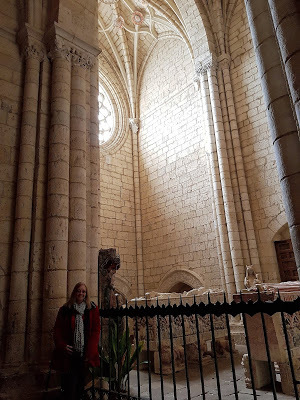 Most tour guides take for granted that the above pictured is the Virgin of the Cantigas. She certainly has the look: early Gothic symmetry and a placid expression dominate the symbols of this lady's important role in Heaven and on Earth, and the colors that emphasize her beauty are nothing if not Alfonsine. It was so widely accepted in the nineteenth century that this is the Virgin who worked the medieval miracles that she was placed in the Santiago Chapel to watch over the magnificent thirteenth-century tombs of none other than Prince Felipe, the younger brother of King Alfonso X, and his second wife.
Most tour guides take for granted that the above pictured is the Virgin of the Cantigas. She certainly has the look: early Gothic symmetry and a placid expression dominate the symbols of this lady's important role in Heaven and on Earth, and the colors that emphasize her beauty are nothing if not Alfonsine. It was so widely accepted in the nineteenth century that this is the Virgin who worked the medieval miracles that she was placed in the Santiago Chapel to watch over the magnificent thirteenth-century tombs of none other than Prince Felipe, the younger brother of King Alfonso X, and his second wife.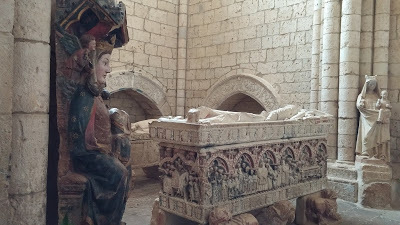 However, reputable art sites and references admit that this might not be that Virgin after all. This Virgin is stone, which isn't the customary material for a devotional image of the thirteenth century. I mentioned the she was moved to the Santiago Chapel--from where? From the Puerta del Ángel. During the time of Alfonso X, this Blessed Mother was outside the church, possibly hanging over people's heads as they came through the door. None of the cantigas in her honor talk about stopping to pay respects outside the church. On the contrary, they mention going inside the church to an altar to pray or hear mass or even sleep. None of these activities has the remotest chance of taking place in the doorway. To me, this means that this stone Virgin, even as Alfonsine as she appears, cannot possibly be the Virgin of the Cantigas.
However, reputable art sites and references admit that this might not be that Virgin after all. This Virgin is stone, which isn't the customary material for a devotional image of the thirteenth century. I mentioned the she was moved to the Santiago Chapel--from where? From the Puerta del Ángel. During the time of Alfonso X, this Blessed Mother was outside the church, possibly hanging over people's heads as they came through the door. None of the cantigas in her honor talk about stopping to pay respects outside the church. On the contrary, they mention going inside the church to an altar to pray or hear mass or even sleep. None of these activities has the remotest chance of taking place in the doorway. To me, this means that this stone Virgin, even as Alfonsine as she appears, cannot possibly be the Virgin of the Cantigas.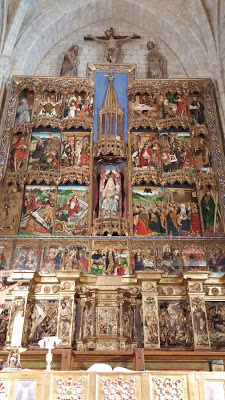 As you can see, as we entered the church, we studied the beauty of the Santiago Chapel and I had my picture taken with the likely spurious Virgin. But I was only too pleased to settle into a pew and listen to mass because from there, I could unabashedly stare at the thirteenth-century Virgin Mary in the center of the main altarpiece. This, I believe, is the real deal, the beautifully sculpted Mother of God that moved a king so deeply, he had fourteen songs written about her.
As you can see, as we entered the church, we studied the beauty of the Santiago Chapel and I had my picture taken with the likely spurious Virgin. But I was only too pleased to settle into a pew and listen to mass because from there, I could unabashedly stare at the thirteenth-century Virgin Mary in the center of the main altarpiece. This, I believe, is the real deal, the beautifully sculpted Mother of God that moved a king so deeply, he had fourteen songs written about her.She's similar in style and symbolism to the Santiago Chapel Virgin and just as symmetrical and placid, but she's made of wood. She was always an indoor Mary. For this reason, she still has her right hand and Baby Jesus still has his head. She's now surrounded by a magnificent fifteenth-century Hispano-Flemish series of panels depicting the life of Jesus.
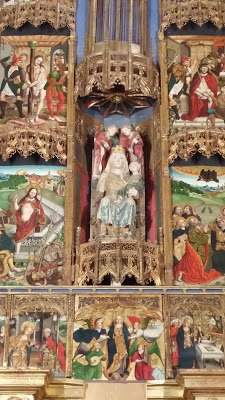 We listened to the whole mass, and the sermon appropriately focused on the way Mary saved the day by noticing that they were running out of wine at the wedding at Cana. Mary had a talent for staying on top of the details when no one else would, said the priest. Every one of us has a special God-given talent, and we must do our duty and let it shine. I felt a tremendous sense of abundance and joy as I considered how to make my talents matter in the world.
We listened to the whole mass, and the sermon appropriately focused on the way Mary saved the day by noticing that they were running out of wine at the wedding at Cana. Mary had a talent for staying on top of the details when no one else would, said the priest. Every one of us has a special God-given talent, and we must do our duty and let it shine. I felt a tremendous sense of abundance and joy as I considered how to make my talents matter in the world.During the part of the mass when the congregation gives each other "God's peace," the priest came into the aisle and shook everyone's hand and even chatted a little before returning to his post to finish. This is the first time I've seen such a warm and welcoming act. It felt like a sign of cosmic approval for the decisions I've made up to this point.
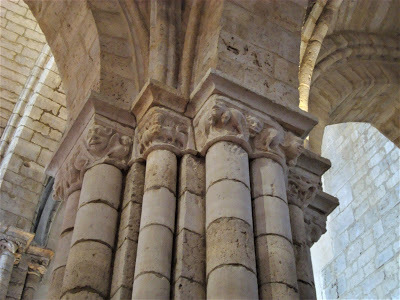 Romanesque fantastic creatures, but the execution is Gothic When the mass was over, I scurried into all four corners of the church, awed by the art and architecture and snapping photos. My friend stood with the priest at the door even after they'd turned off the lights, and explained that I've studied the Cantigas and was thrilled to be in Villalcázar de Sirga at long last. The priest was flattered by our interest and let me hang out a little longer than he would have if my friend hadn't mentioned my lifelong devotion.
Romanesque fantastic creatures, but the execution is Gothic When the mass was over, I scurried into all four corners of the church, awed by the art and architecture and snapping photos. My friend stood with the priest at the door even after they'd turned off the lights, and explained that I've studied the Cantigas and was thrilled to be in Villalcázar de Sirga at long last. The priest was flattered by our interest and let me hang out a little longer than he would have if my friend hadn't mentioned my lifelong devotion.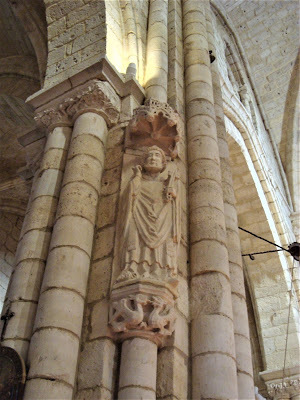 Peter with the keys to the pearly gates When I joined them at the door, the priest explained to me that no one was really sure which Virgin is she of the Cantigas. Given my foreign looks--and probably my pesky accent doesn't help--I often get "Spainsplained." "I have my doubts about that, too," I said cheerily.
Peter with the keys to the pearly gates When I joined them at the door, the priest explained to me that no one was really sure which Virgin is she of the Cantigas. Given my foreign looks--and probably my pesky accent doesn't help--I often get "Spainsplained." "I have my doubts about that, too," I said cheerily.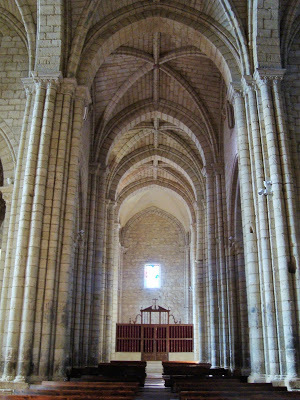 You can get a sense of the grand scale looking toward the foot. It was still early to think about having lunch after we gave our sincere thanks and bid the priest and the Virgin farewell, so we stopped in Las Cantigas, where the whole town had gathered. In among the townsfolk were people with the enormous backpacks and walking gear that are the giveaways of pilgrims, and we wondered why they had come all that way and not gone inside the church. Possibly they believed the website and thought the church was open after siesta for visits. Before we left, the priest came into the pub to continue his friendly duty.
You can get a sense of the grand scale looking toward the foot. It was still early to think about having lunch after we gave our sincere thanks and bid the priest and the Virgin farewell, so we stopped in Las Cantigas, where the whole town had gathered. In among the townsfolk were people with the enormous backpacks and walking gear that are the giveaways of pilgrims, and we wondered why they had come all that way and not gone inside the church. Possibly they believed the website and thought the church was open after siesta for visits. Before we left, the priest came into the pub to continue his friendly duty.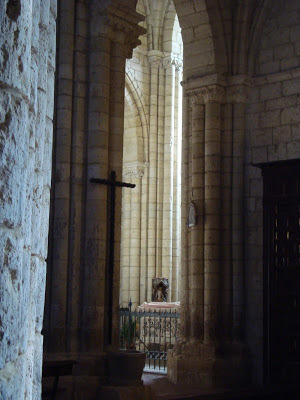 The stone Virgin is dwarfed in the light from
The stone Virgin is dwarfed in the light from the rose window. When I returned home, I told my roommate about the important things I'd accomplished that very day. I'd left home two days before, too ill to walk to the bus station. I returned aglow with inspiration and wellness. "Now that I've done this, I think I'm good for the rest of my life," I told my roommate.
"I can tell!" he said.
Just one more miracle from Villalcázar de Sirga.
Published on January 27, 2019 11:26
January 22, 2019
Villalcázar de Sirga: The Miracles
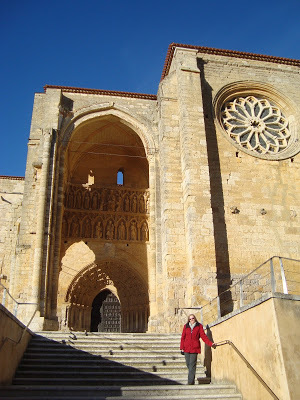 Yours truly with the grand Gothic door and rose window
Yours truly with the grand Gothic door and rose windowat Villalcázar de Sirga
Photos in this post 2019 Jessica Knauss As many readers of this blog know, I wrote my doctoral dissertation on the Cantigas de Santa Maria because they are so inexhaustibly wonderful. Sometimes I don't think about them for a while, but they're always available for another round of fascination.
One reason I keep going back is that the stories they tell are so uplifting. There isn't a single sad ending in the entire set of more than 400 songs. (There are a few questionable ones at first blush, but if a modern reader thinks about them a little, s/he can come away with a message about the power of belief at the very least.)
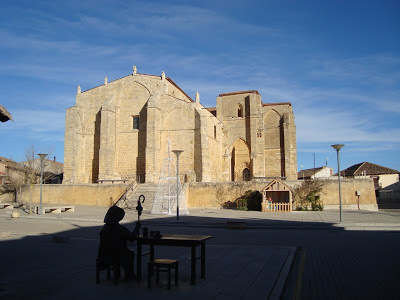 A monumental pilgrim contemplates the western facade of Villalcázar de Sirga. Imagine the happiness boost I got recently when I visited one of the sanctuaries most often mentioned in the Cantigas.
A monumental pilgrim contemplates the western facade of Villalcázar de Sirga. Imagine the happiness boost I got recently when I visited one of the sanctuaries most often mentioned in the Cantigas.The town of Villalcázar de Sirga in Palencia is "two leagues" from Carrión de los Condes, an important stop on the pilgrims' Road to Santiago de Compostela. This route culminates at the end of the known world, Galicia, where the remains of St. James the Apostle were miraculously discovered in the ninth century. The pilgrimage enjoyed enormous popularity for centuries and established a bustling hospitality economy. Shrines close to but not directly on the Road had a vested interest in capturing the attention of so many travelers, and nothing pulled them in like a good miracle--or fourteen. That's right, the Virgin of Villalcázar de Sirga (known as Villasirga at the time of the Cantigas) was a great miracle worker, and the cantigas poets and musicians recorded fourteen of them for posterity, and to get word out about this church so close to the pilgrimage route and attract at least a few of the faithful.
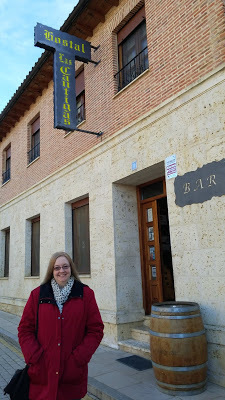 The town pub is called "Las Cantigas"! Cantiga 31: A farmer loses his cow. He's already had others killed or maimed by wolves, so he prays to the Virgin Mary, promising her the calf the cow is carrying if only the cow comes home. Of course, it does, and promptly gives birth to a healthy calf. The calf is so wonderful, in fact, that the farmer decides not to donate him to the Church, taking him with many other animals to sell in Villasirga. When the farmer tries to sell him, the calf runs away, straight into Mary's church, where he stops in reverence before Mary's altar. The calf eats with the other oxen donated to the church and becomes the church's best working ox, without ever needing to be prodded or beaten. The farmer, accepting the miracle, tells everyone he knows.
The town pub is called "Las Cantigas"! Cantiga 31: A farmer loses his cow. He's already had others killed or maimed by wolves, so he prays to the Virgin Mary, promising her the calf the cow is carrying if only the cow comes home. Of course, it does, and promptly gives birth to a healthy calf. The calf is so wonderful, in fact, that the farmer decides not to donate him to the Church, taking him with many other animals to sell in Villasirga. When the farmer tries to sell him, the calf runs away, straight into Mary's church, where he stops in reverence before Mary's altar. The calf eats with the other oxen donated to the church and becomes the church's best working ox, without ever needing to be prodded or beaten. The farmer, accepting the miracle, tells everyone he knows.Cantiga 217: A powerful count from France arrives in Villasirga while on pilgrimage to Santiago. He has ten knights with him, and wants to enter the church before them. No matter what he does, he can't move past the threshold and set foot inside the church. His men push him so hard that blood gushes from his mouth. There is no going inside this church! The French count finally realizes what's wrong, and confesses his sins right there in the doorway. After that, he walks in effortlessly.
Cantiga 218: A German man who is "paralyzed" (in this case, probably quadriplegic), goes along on the Santiago pilgrimage with a group of people who aren't thrilled to have to deal with his special needs. Even though they make it all the way to Santiago, the German man's afflictions aren't cured. In fact, on the journey back, when they reach Villasirga, he also goes blind! Afraid he'll die and they'll be blamed, the other pilgrims abandon him inside the church. The German man prays in desperation to Holy Mary, and although St. James couldn't cure him, the Virgin of Villasirga does, right there and then. He can see and move about freely. The man returns to his lands to tell everyone about the wonderful miracle and also goes back to Villasirga to make votive offerings.
Cantiga 227: A squire who makes yearly pilgrimages to Villasirga is obliged to go to war in Sevilla, where he's taken captive. He prays to Mary every day for his release. When her feast day, August 2, rolls around, he's especially sad, and his captors ask him what's wrong. When he tells them he wishes he could be in Villasirga for the feast day, they beat him all over and throw him into an even worse dungeon. Mary appears to the squire and breaks his chains. The captors don't hear any activity, and they don't see him walk out of the prison. When he arrives in Villasirga, he hangs his broken chains at the church as a testament to the miracle granted him.
Cantiga 229: Moorish soldiers sent by the King of León invade Villasirga, and the Christians of the area flee in terror. The Moors enter the unprotected church and try to tear it down and burn it, but there's no way. Holy Mary makes them lose the strength in their limbs and go blind. In the end, they have to be carried out of the church. The message is that the Virgin is more powerful than any of Castile's enemies and can take them on any day.
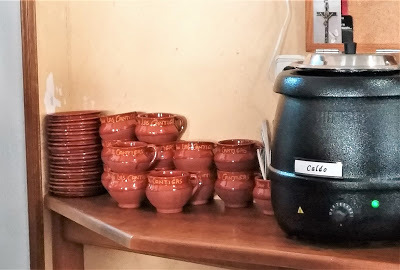 Soup tureens that have "Las Cantigas" painted on them!
Soup tureens that have "Las Cantigas" painted on them!They weren't for sale. Of course I asked! Cantiga 232: A knight from Treviño has the best goshawk in the kingdom, and one day while hunting, he loses it. He searches all day and never finds the prized raptor. He sends his men to look far and wide, but though they never stop searching, they don't find the goshawk for four months. The knight weeps so much he thinks he'll go mad, then has the brilliant idea to have a wax goshawk made. He takes the votive offering and places it on the altar in Villasirga, invoking the Virgin's great power in his prayers. He returns home, and when he opens the door, he sees the goshawk on the perch where it should always have been.
Cantiga 234: A deaf-mute boy is raised by Don Rodrigo, one of the king' noblemen. Rodrigo goes to Villasirga with the boy and has him sleep right in front of the altar. Rodrigo has a mass in honor of the Virgin sung in the morning. During the "secret," the boy's tongue loosens, and by the time mass is over, the boy speaks and hears perfectly.
Cantiga 243: Two of King Alfonso's falconers foolishly go hunting by themselves. Their falcons send the ducks they're hunting into a frozen stream. The falconers run to the ice to see where the ducks are and fall into the water. The ice covers them over! They call out to Mary for some time, and finally the ice dissolves and they get out of the stream, unharmed.
Cantiga 253: A Frenchman has committed such tremendous sins that his priest sets him a hefty penance: He must walk the pilgrims' Road to Santiago carrying a 24-pound iron staff big enough for all the other pilgrims to see. He makes it to Villasirga, and begs the Virgin's forgiveness, laying the heavy staff at the altar. When he finishes his prayer, the staff breaks in two, and the pieces cannot be moved from where they fall. (The Virgin is telling him he needn't continue with the penance because she forgives him already.)
Cantiga 268: Although she attempted to find a cure for her paralysis at many other shrines, a French woman doesn't get well until she comes to Villasirga. After offering candles and prayers, she can move about freely.
Cantiga 278: A blind French woman makes the pilgrimage to Santiago. Although she's not expecting it, in Villasirga she regains her sight. On the way home, she comes upon another blind pilgrim. She tells him not to bother going to Santiago. He'll be cured in Villasirga, without a doubt.
Cantiga 301: Although a man always fasts on Mary's high holidays in her honor, he has committed a serious crime, the sentence for which is death. In prison awaiting execution, he prays to Mary. In his dreams, she appears in his cell, breaks his chains and takes his hand. He wakes to find himself in front of the altar at Villasirga! People in the church witness his appearance as if out of thin air. Medieval teleportation, folks.
Cantiga 313: A ship sails into a terrible storm and everyone is in danger of losing their lives. The call out to all the saints, but the storm continues and gets fiercer. When a priest has everyone on board sing Salve Regina for the Virgin of Villasirga, a white dove appears, and the sea calms. The ship arrives safely in port in the morning.
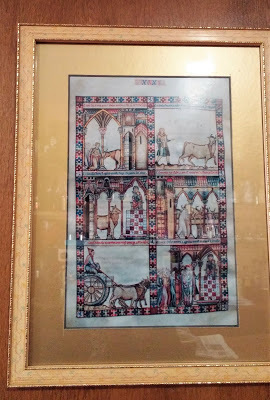 A framed print of Cantiga 31's miniatures in the bar. Cantiga 355: A man is pursued relentlessly by a young woman he doesn't like at all. She follows him on his travels, asking constantly why they can't get married and why don't they make love just to try it out. When they stop at Villasirga, he donates the money for one of the stone blocks needed to build the church. This is an important investment, both financially and spiritually. A final rejection is the last straw for the young lady, and she accuses the man of rape in the spirit of bitter revenge. He's taken immediately to the gallows, but through a miracle of Mary's doing, the very stone block he's bought for the church appears under his feet, keeping him from strangling. He stands upon the block all night, and in the morning, everyone sees the miracle and lets him go.
A framed print of Cantiga 31's miniatures in the bar. Cantiga 355: A man is pursued relentlessly by a young woman he doesn't like at all. She follows him on his travels, asking constantly why they can't get married and why don't they make love just to try it out. When they stop at Villasirga, he donates the money for one of the stone blocks needed to build the church. This is an important investment, both financially and spiritually. A final rejection is the last straw for the young lady, and she accuses the man of rape in the spirit of bitter revenge. He's taken immediately to the gallows, but through a miracle of Mary's doing, the very stone block he's bought for the church appears under his feet, keeping him from strangling. He stands upon the block all night, and in the morning, everyone sees the miracle and lets him go.(I don't love this last one with the false rape accusation, but I think it's the only one in the Cantigas, at least.)
As you can see, these happy miracles describe every level of society and include details the history books of the time would be hard pressed to include. The Virgin Mary, especially as expressed in her image at Villasirga, is the universal mother and thirteenth-century Spain's greatest hope for prosperity, happiness, health, and salvation.
In the next post: meet the lady herself!
Published on January 22, 2019 09:02



